One of my all-time favorite websites is The Art Renewal Center. For there, you can go to the museum and see thousands of beautiful, and stunning, works of art by masters at the craft. No, I’m not talking about a photograph of dog piss on a cross in a jar, either. I am talking about art that stirs the emotions and causes you to stop dead in your tracks and stare at the work for hours.
Art is a reflection of what it means to be a human.
As the world unravels away from the old and enters a new state of being, we need to remember that it is our human-ness that will become the “valuable commodity” that will bring the world together. This “human-ness” encompasses many, many things.
- Passion.
- Kindness.
- Strength of character.
- Helpfulness.
- Compassion.
Here, in this post, I want to talk about art, but what art really is and what it represents. For real art is an expression of our human-ness. While progressive, modern reconstructive art is an expression of the exact opposite.
Art, real expressive art, moves the soul.
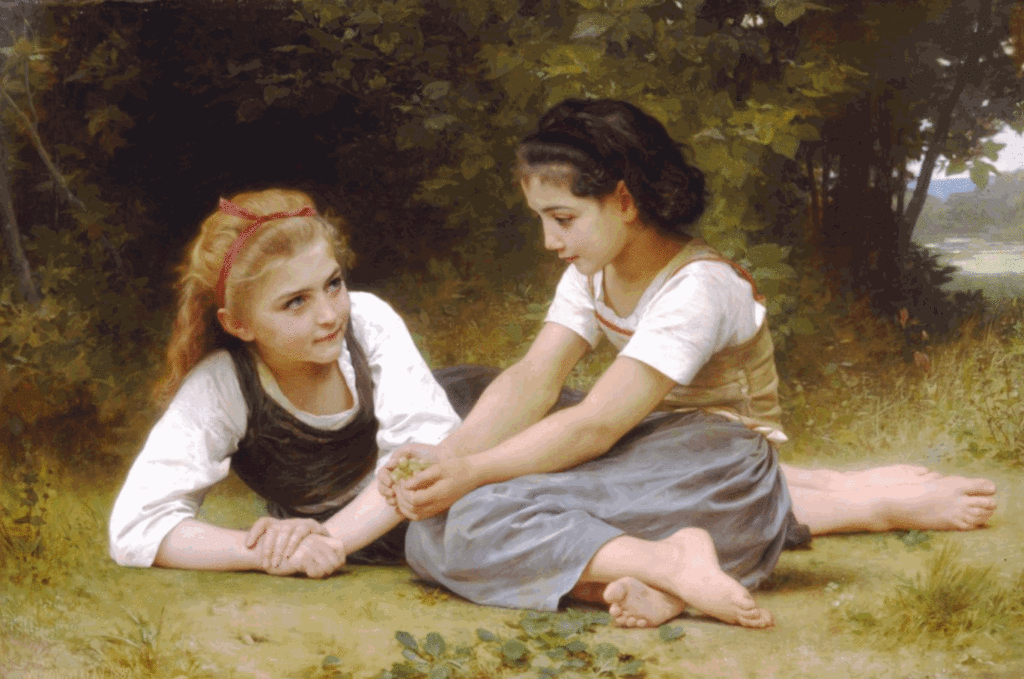
Excerpt from ARC Chairman Fred Ross's 2002 speech at the Salmagundi Club: In October 1977, I walked into the Clark Museum to see their thirty Renoirs, and after leaving the Renoir galleries walked out into a major hall, at the end of which was a painting that grabbed me body and soul. It was a life-size painting of four water nymphs playfully dragging a mythological satyr into a lake against his will. Frozen in place, gawking with my mouth agape, cold chills careening up and down my spine, I was virtually gripped as if by a spell that had been cast. It was so alive, so beautiful and so compelling. Finally, after about fifteen or twenty minutes of soaking up wave after wave of artistic and spiritual ecstasy, I started to take back control of my consciousness .... my mind started racing with unanswered questions. My first thought was "I haven't felt this way about a work of art since I stood before Michelangelo's David. Then I thought, "This must be one of the greatest old master paintings every produced. But no name or country or time would come to mind. Italian High Renaissance, 17th Century Dutch, Carravaggio, Fragonard, Ingres, Prudhon ... back further perhaps ... Raphael, Botticelli, Leonardo, no! no! NO! Not one of those names or times felt anything like what I was looking at. Then I approached the painting more closely, and saw the name mispronouncing it as Bouguereau at the bottom, and the date 1873 -- 1873? How was that possible? I'd learned that the greatest artists at that time were, Manet, Corot, Courbet, and Renoir ... that the techniques and greatness of the old master's had died out, and that nobody knew how to do anything remotely this great by the 1870's. Years of undergraduate courses and another sixty credits post graduate in art, and I had never heard that name. Who was he? Was he important? How could he not be important? Anyone who could have done this must surely be deserving of the highest accolades in the art world. Then I asked the guard if they had any more works by him, and he asked somebody else, and I was led to a second work of a single female nude, seated by the water holding her knees. It was one of the finest nudes I had ever seen. In somewhat of a state of shock from this experience, I decided that I must find out if this artist ever comes up for sale at the largest auction house in New York, Parke Bernet who was years later bought out by Sotheby's. Was he deemed important enough to be sold at auction? My only experiences collecting up to then at auction was to purchase a few etchings by old master's: Rembrandt, Durer, Breughel and Goya. But they were very famous names. I was at the Clark on Sunday October 2nd 1977, I stopped in at Sotheby's that Tuesday October 4th, and as fate would have it, there were three Bouguereau paintings being offered for sale that coming Friday. I purchased one called Les Enfants Endormis, of two babies asleep in each other's arms. The hands of fate certainly seemed involved, for later I learned that these were the first Bouguereaus to come up for sale in the last eighteen months, and another was not to appear on the auction block until twelve months later. So the timing could not have been any more precise for fortuitous. I remember too, there was an energy of excitement in the air, and I somehow knew that I would never again be able to purchase works by these artists at these prices. But I didn't know which ones to buy. And I still didn't know who he was. During the next few weeks I started researching Bouguereau and the entire period as much as I could using any free time I had. But almost immediately, I discovered that he had won the Grand Prix de Rome in 1851 at the age of twenty-six, and after winning nearly every accolade and award imaginable for an artist of his time, ultimately become the President of the Academy, Head of the Salon, President of the Legion of Honor. He was in fact, considered the greatest French artist of his time, and Paris was the center of art world. All this made me feel very good about my instincts, and that I had intuitively identified as being one of the worlds' greatest artists somebody who had generally been considered as such by most of the world during the final decades of the 19th century.
It was sometime in the early 1960’s and I was with my parents visiting museums and other cultural structures. As my family went inside the museum, I stayed in the lobby. I stood on the steps and spend a timeless period staring at this enormous picture of a Satyr being pulled into a pool of water by water nymphs.
My father chucked.
He said “You like that picture, don’t you?”
I don’t remember what I said back, but I do remember that I did not want to leave the museum. I didn’t even look at the Renoirs, except for a sculpture or two in the courtyard. None of them appealed to me. All that mattered to me was the image of the satyr and the nymphs.
It haunted me during the drive home and all afternoon.
I never forgot that image…
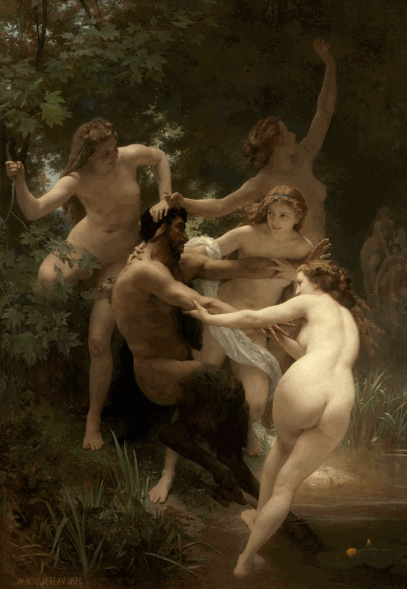
Four nymphs tease and play with a satyr by trying to pull him into a lake. One nymph waves behind to three other nymphs in the distance, perhaps beckoning them to come and play with the satyr as well. The satyr half-heartedly tries to resist the nymph’s wiles, entranced by their beauty.
As an aside, consider this interesting article in the New York Times, published April 7, 2000, by KATIE HAFNER: Lenn D. Lowry, the director of the Museum of Modern Art [let me repeat 'the director of the Museum of Modern Art'], has a vivid memory of the first time he was profoundly moved by a work of art. At age 7, during a visit to the Sterling and Francine Clark Art Institute in Williamstown, Mass., he was separated from his parents. "While wandering in search of them, he came upon a huge painting, Nymphs and Satyr, by William Bouguereau. His parents found him a half-hour later, still staring at the 6-by-8-foot painting. 'I just remember being completely transfixed by it,' said Mr. Lowry, who is now 45. "The experience helped Mr. Lowry believe in the transformative power of art and what he calls the 'unique encounters that occur when one is fortunate to confront directly an extraordinary object.' Mr. Lowry, as well as other museum directors, wants to broaden the opportunity for such transforming moments by providing encounters with virtual art, viewed on a computer screen and brought to the art-viewing public via the World Wide Web.
Nymphs are from Greek mythology. They are considered to be minor female deities, and have a duty to protect different elements of nature such as streams, mountains and meadows (pantheon). The male counterpart for a nymph is a satyr. A satyr is a creature also from Greek mythology having the torso and face of a man, ears and tail of a horse, and feet of a goat. They are known for being lustful and fertile creatures.
Bouguereau captures an incredible sense of motion in this piece. One can feel the struggle for the satyr to keep his ground, and the nymphs’ joyous struggle to pull him in. The three-dimensional rendering of form and movement is reminiscent of some of Bernini’s most famous works at the Palace Borghesi in Rome, such as Pluto and Proserpine, and Apollo and Daphne.
The following is the stunning philosophy statement from the founder of the website. It is reproduced herein in it’s entirety. Please give it a read.
The Philosophy of ARC
Why Realism?
by Fred Ross
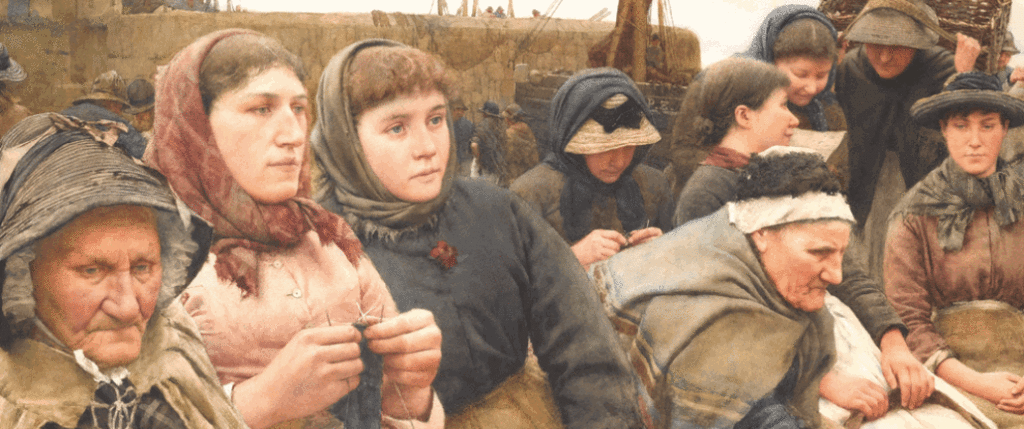
Introduction
Fine art at its best has the power to move one to tears, or grab your sensibilities and rivet you in the moment with an overwhelming sense of beauty and excitement. People often report the sensation of cold chills going up and down their spine. It may be the rare work that accomplishes this, but for those who have had this experience, many have credited it as the stimulus that set them on a personal lifetime quest; whether as an artist, collector or art historian. Other human activities can create a similar experience, whether in poetry, literature, dance, theatre, or music, but it is the experience of beauty in fine art and beauty and its relationship to fine art that is the focus of this essay.
If you are reading this, in all probability you are one of the millions of art lovers who in the 21st Century are disillusioned with the Modernist paradigm which for more than a century has been the dominant way the concept of art has been taught and presented in nearly all institutions of higher learning throughout the world.
If you are like us, it seems more than a little self-evident to you that works of art have infinitely more to say and communicate if they portray the real world, or use figures and objects from the real world even when portraying fantasies and dreams. You experience such “realist” works as infinitely more successful than any Modernist works.
The success of Modernism seems like a form of mass insanity, a nightmarish anomaly from which we pray the art world will finally soon awake.
For most of the 20th century, people who felt as we do, found themselves attracted to fine art in most if not all cases from having been to museums and fallen in love with a number of works of art created in the 15th through 19th centuries.
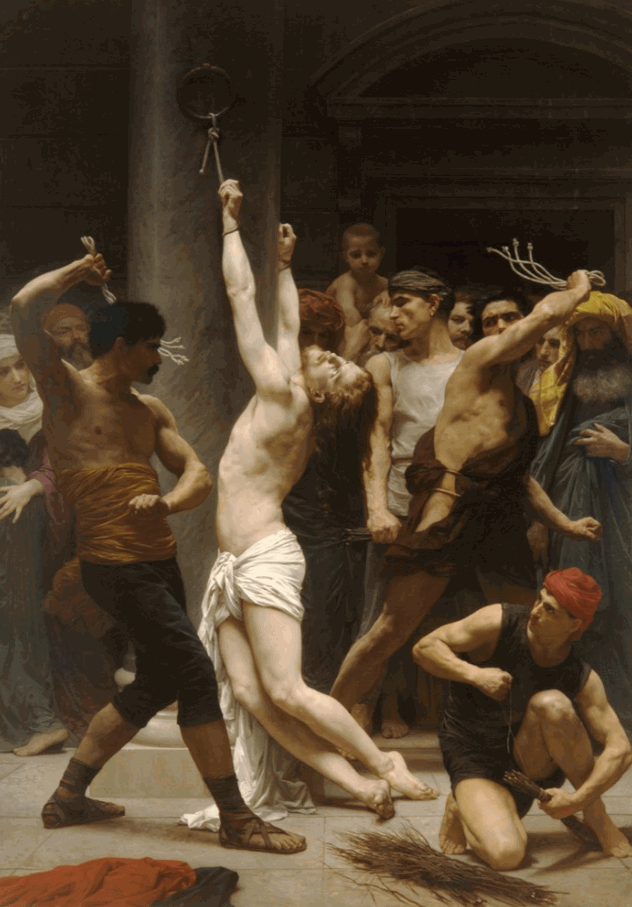
You may have wanted to become an artist yourself and were channeled by advisors into fine art courses taught in the art departments of colleges and Universities where you were promptly told that your instincts were all wrong.
That such works had a place in their time, but that modernist works were far superior. What followed was an attempt to change your attitudes and beliefs and to convince you that works, which commemorated the destructions of some aspect of what used to be traditional Realism were the only worthwhile artworks and concepts.
You were never told that these “educators” had never themselves learned any of those skills needed by all artists during prior centuries, and so were completely bereft of any of the experience, skills and knowledge for which you had assumed your tuition bills would be paying.
They made you believe that they all could draw and paint but had chosen to abandon those skills due to some great epiphany.

If you were true to yourself and your feelings and beliefs, you probably left that “art” department and considered doing something else with your life. Many of you went into commercial art. Others became art historians, but most found other fields entirely. A rare few of you searched out and found one of a handful of ateliers who actually still taught the methods of the old masters. To the best of our knowledge there were 7 such ateliers in 1980 and all of them were taught by students of Pietro Annigoni or Ives Gammell 1. Both atelier masters could trace their training seamlessly to the 19th century and beyond.
By 2002 when the Art Renewal Center decided to add to their website a section of ARC Approved® Ateliers schools the number of such schools had grown to 14 with each having between 5 and 15 students. We added a map of the world where it became very easy to identify all the schools and to find the nearest one to any local. Within a few months the numbers of students able to find these schools started to grow geometrically, and today, just 14 years later, there are over 100 schools teaching the atelier style training and thousands of students.2
So, what do all these students and educators see that Modernists do not? And why is it that most educated people who are not part of the art world seem to also prefer traditional realism?3
The purpose of this essay
It is the purpose of this essay to answer that question in the clearest most direct way possible. It is also to help establish for artists and the consumers of art, a set of criteria by which they can judge works of art. Where they can understand their own preferences. And if needed, to arm them with the facts, concepts and information to deal with the modernists, educators and apologists who are constantly attacking and denigrating the skills and subjects which enable fine art.
The skills like with literature, poetry and theatre that enable us to communicate our shared humanity.
We will accomplish this by delineating a simple way to understand and define what fine art is. We will also look in particular at the aesthetic foundation of fine art as it evolved during the 19th Century. As well as the Modernist juggernaut which almost lead to its complete suppression during most of the 20th Century.

The following information also advances criteria by which to view artists and movements, and help to determine why some works of art are experienced as beautiful and successful and why others seems to fall flat or are even boring. It will hopefully also satisfy the needs of practicing artists to determine what type of art and subjects they wish to explore and which skills and techniques they will need to learn and practice in order to accomplish this.
As in all education, individuals should ultimately decide for themselves what makes sense and what is nonsense or babble.
Beauty and Fine Art Versus Craft
To determine a cohesive theory on fine art (or aesthetics) we need to answer this question:
What Makes Something Beautiful Or Aesthetically Successful?
The purpose of fine art is to create beauty in the broader sense4, or to create works of art that are experienced as beautiful. Therefore, it would seem that the definition of fine art itself is inextricably tied to successfully defining beauty in art as opposed to beauty in the natural world. There are generally recognized works of art that are experienced as beautiful by most people. In addition, people are motivated to surround themselves with objects of beauty and to create art as a life enriching and life-affirming experience.
In the fine arts there are two over riding kinds of beauty. There is beauty of form and there is beauty in thought, idea or subject matter, in essence its’ emotional, intellectual and spiritual thrust. What is the purpose or what are the feelings that the artist is attempting to capture or express? Then all the choices made of size, drawing, modeling, composition, color, design, perspective, etc., are all formal elements that make up the forms used by the artist to support and harmonize with the chosen emotional thrust. If the artist has chosen well and successfully marries idea and form, then it is possible for a great work of art to be created. Beauty in forms, minus any specific subject or idea, can and does exist in many objects created by human beings, but it is combining them with subjects and themes that makes a work fine art.5
Some examples of things that are beautiful that do not have a specific subject would be:
- Persian rugs,
- English silver,
- porcelain,
- Russian enamel,
- haute cuisine,
- high couture,
- furniture etc.
Beauty in such things is a different type of beauty and generally encompasses beauty of form without incorporating beauty of idea, subject or theme. It should be noted that there are many exceptions to this general rule. For example, the Gate of Paradise, the famous golden door of the Baptistery in Florence; spirituality, religious feelings of transcendence engendered by the architectural splendor achieved in great cathedrals temples or mosques.
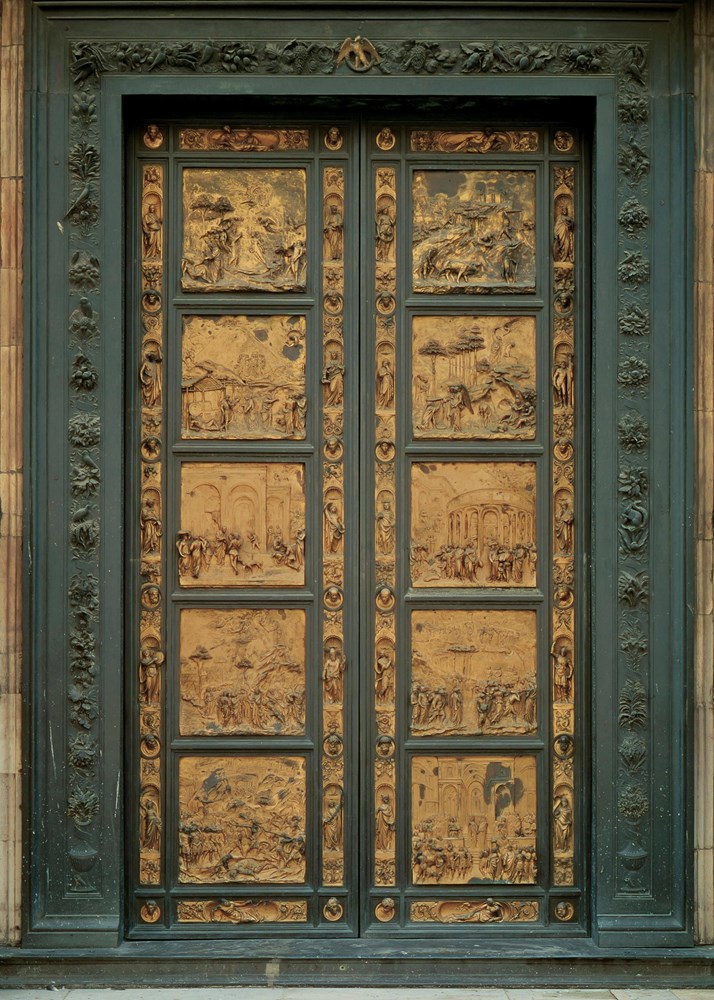
Individual reliefs: 31 1/4 x 31 1/4 inches (78.74 x 78.74 cm)
Duomo Museum, Florence
So how are we to differentiate fine art from these other human activities and achievements? The single clear element of differentiation is that all of these other activities at their best are the product of highly skilled crafts people who are creating objects with varying levels of skill and complexity. These objects may be experienced as attractive, handsome or elegant, and are also usually functional in some way. In some cases, even functionality isn’t essential.
An example might be a finely knotted silk Persian or Indian rug, which may be hung on the wall as decoration instead of being walked upon; though it still may be useful to warm the room and perhaps improve the acoustics.
We will call these other creative, often important, sometimes essential instances of human creativity “craft”, fine craft, or finely crafted. So what makes “fine art” different from “fine craft”?
Fine craft produces objects that are functional, beautiful and well-constructed to last and to perform a needed or desired function and often to also delight the senses. It can even be demonstrated in things that don’t have a physical presence. If a mathematician solves a math problem in a way that is overly burdensome and complex his peers may feel that his proof lacks elegance.
But if another mathematician finds a much more direct solution which is clear and bypasses half the steps, using a new creative path to come to the same conclusion, his peers will praise the elegance and even aesthetic beauty of his solution. Depending on the field of endeavor the sense of aesthetics or beauty can and will vary based on specific aspects of the goals that are sought.
In each field there will be ways to determine beauty and elegance versus banality and ugliness, and while differences of motivation and taste would surely cause differences of opinion, most people who create or consume the output of each craft usually concur to a significant degree. But what is different about fine art? What does it seek to accomplish which makes it worthy of designating this art as fine art?
The term “state of the art” is a wonderful phrase and aids us in understanding this difference. Every other form of craft has evolved and developed over the course of human history and the best and most exceptional examples in each field are held up prototypically and called “state of the art”.
Of course that phrase is used in science, engineering, mathematical theories and computer programing and in all other technologies, many of which produce things of great value for humanity. It is a matter of opinion whether Fine art is superior to science or even crafts for that matter.
Regardless, it has a different purpose and fills a different human need. That need is in its ability to communicate and capture and express ideas about life and living which people care about after their basic biological needs are filled.
People need to share their lives and feelings with other people and this is done through communication which helps give meaning to our lives.
Most communication is in spoken and written language.
Fine art also communicates, which it does best when it successfully captures, depicts, and expresses our shared humanity: how we feel about ourselves, other people and the world around us. It may be seeking to capture an emotional state of mind like reverie, jealousy, joy, sadness, fear, etc., or it may attempt to tell a story like Ghiberti’s famous scenes from the Old Testament on the doors of the Baptistery in Piazza Duomo in Florence or Norman Rockwell’s Homecoming Marine.
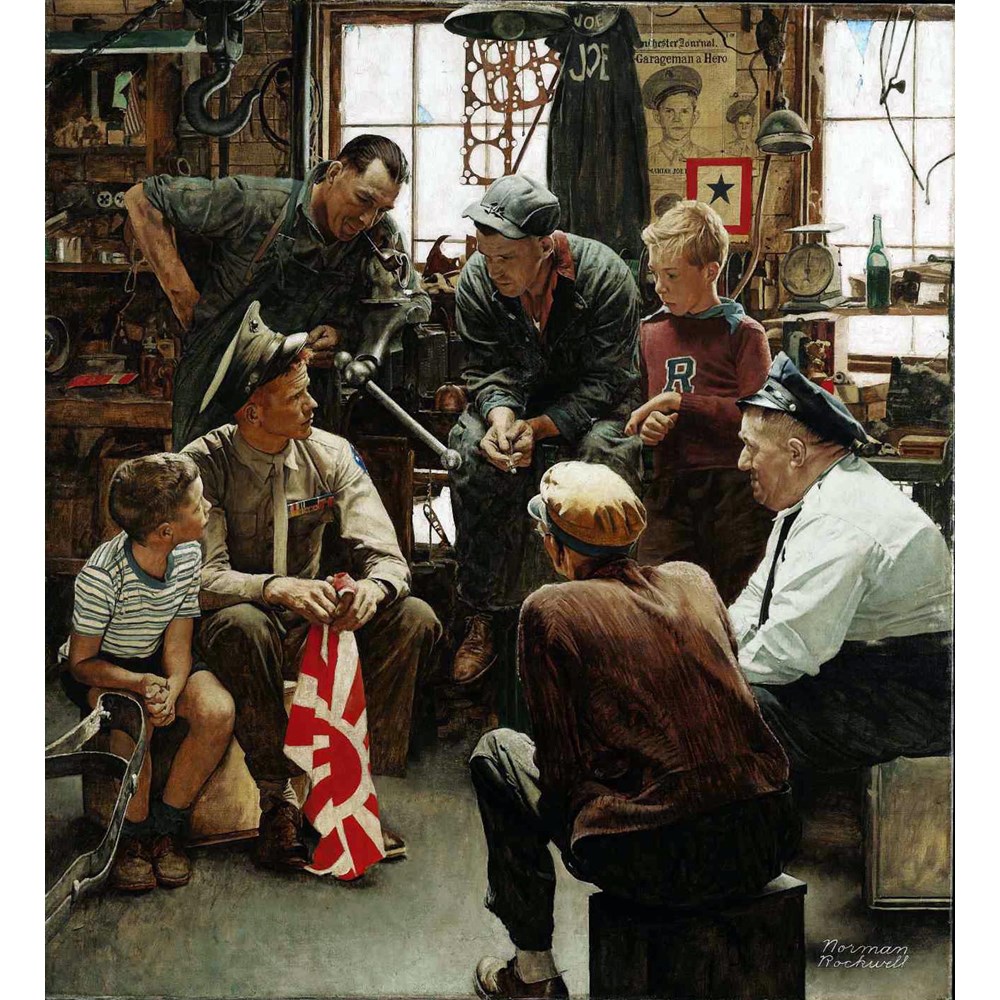
Oil on canvas, 1945
46 x 42 inches (116.8 x 106.7 cm)
If someone with little skill attempts a work of fine art it will likely be unsuccessful or awkward and fail, but an attempt at fine art was still made as opposed to an attempt at fine craft. Failure to achieve doesn’t turn fine art into craft or vice versa.
All of the other crafts and sciences (other than pure research*) have a utilitarian purpose or a purely decorative purpose, but in fine art, human beings endeavor to look at themselves and others, to contemplate the nature of living as a human being, and to find ways of capturing, expressing and communicating with empathy, passion and compassion the road we all must take between birth and death. So, the purpose of fine art is similar in its goal to the purpose of poetry, fine literature or theatre.
Based on the above, I posit:
The visual fine arts of drawing, painting and sculpture are best understood as a language ... a visual language. Very much like spoken and written languages, it was developed and preserved as a means of communication. And very much like language it is successful if communication takes place and unsuccessful if it does not.
This simultaneously helps define the term “Fine Art.” So fine art is one important way that human beings can communicate.
This realization conversely poses the question:
Can it be fine art if it does not communicate or does not even attempt to do so?
Communication can only occur if the language of the speaker is understood by those who are listening. An absolute necessity for communication is that the language employed has vocabulary and grammar shared by speaker and listener or by writer and reader and therefore logically by painter and viewer.
The earliest forms of written languages used simple drawings of real objects to represent those objects as observed in Hieroglyphics and the earliest cave drawings. The origins of written language and the origins of fine art overlap in this nearly identical way. Without a common language there is no communication and no understanding, whether in writing, speaking or fine art.
All three have the uniquely human purpose of describing the world in which we live, and how we feel about every aspect of life and living.
As a language, fine art is like all of the hundreds of the spoken and written languages that are capable of expressing the enormous, limitless scope of human thoughts, ideas, beliefs, values and especially our feelings, passions, dreams, and fantasies; all the varied experiences and stories of humanity.
The vocabulary of fine art are the realistic images which we see everywhere throughout our lives. The grammar is made up of the rules and skills needed to successfully and believably render the images.6
Here are some of the rules of grammar which hold together the real objects or vocabulary of the visual language of fine art: finding contours; modeling; manipulating paint to create shadows and highlights with the use of glazing and scumbling which enhances the form through layers of pigment; use of selective focus; perspective; foreshortening; compositional balance; balancing warm and cool color; lost and found shapes and lines, etc.
Now ponder this self-evident truth:
Even our dreams and fantasies as well as all stories of fiction, which are not real, are expressed in our conscious and subconscious minds by using real images. Only real images are used in our fantasies and dreams ... none which look like modern art. Therefore, non-objective abstract painting does not reflect the subconscious mind. Dreams and fantasies do that and artwork can also do that; but only by using real images and assembling them in ways that feel like fantasies or dreams.
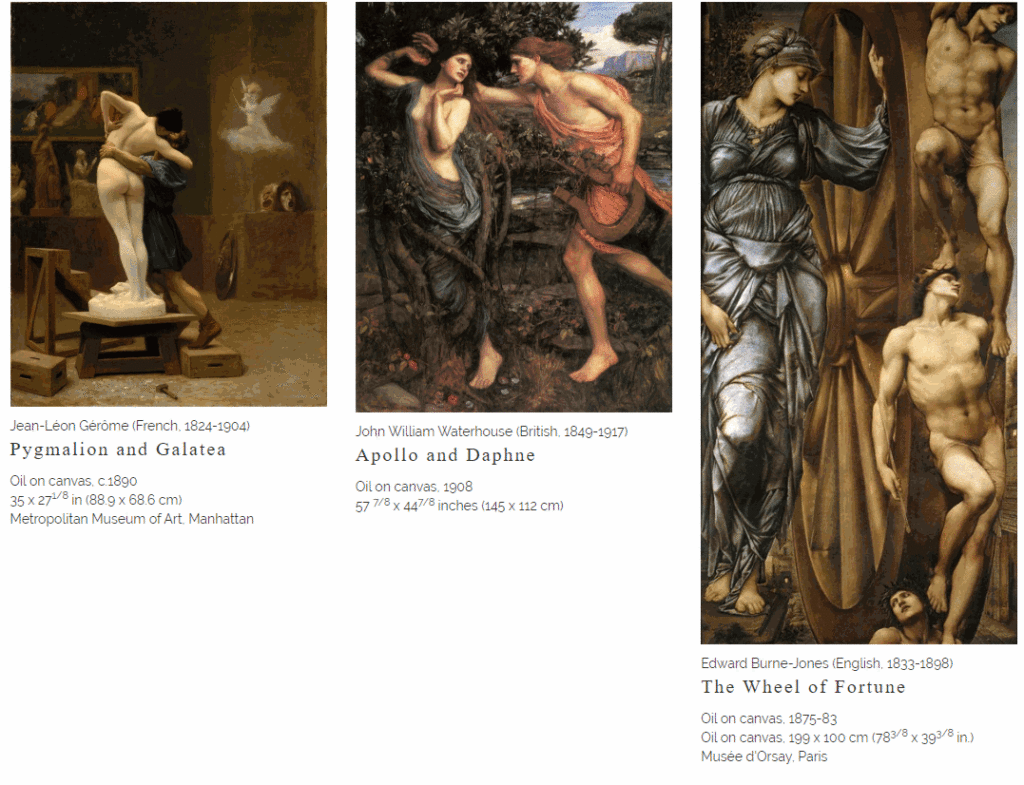
Compare these now to two artist who are considered amongst the greatest Abstract Expressionists: William De Kooning and Jackson Pollock.
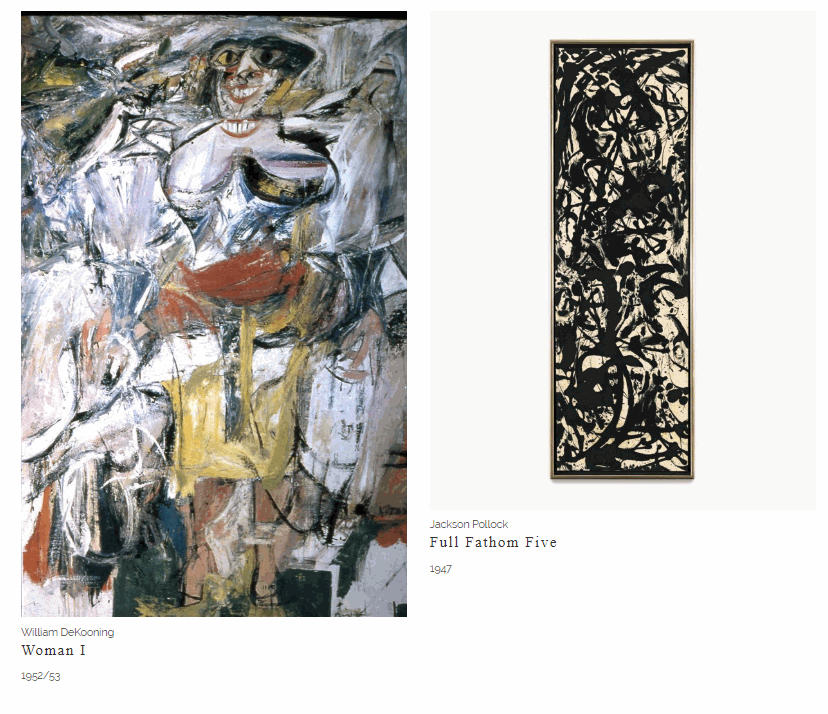
What is being communicated in these two Modernist paintings and which method of working is more successful way to communicate, realism or abstract?
Universality
Furthermore, the vocabulary of traditional realism in fine art has something which makes it unique, in one important way … the language of traditional realism cuts across all those other languages and can be understood by all people everywhere on earth regardless of what language it is they speak or write.
Thus Realism is a universal language that enables communication with all people, past ... present ... and future.
Modernist and abstract art is not a language.
It’s the opposite of language because it represents the destruction of the language of fine art and is therefore the absence of language. The absence of language means the loss of communication; it takes away from mankind perhaps our most important characteristic … that which makes us human…the ability to communicate in great depth, detail and sophistication.
And in the case of fine art;
The Modernist paradigm banished the only universal language that exists: realistic imagery, with the techniques and skills required to achieve it. This knowledge had grown, developed, and was carefully documented and preserved as it was passed down for centuries from masters to students.
The artist tries to express his or her feelings about life and to communicate with others through their art. The artist has found a constructive way to deal with the truth of human existence, the knowledge that we all die.
Instead of shaking their fist at eternity and being overcome by sadness, hate and depression, the artist “rages at the dying of the light” (to quote Dylan Thomas) seeking to overcome for themselves and their audience the basic loneliness of existence.
They strive not to be engulfed by despairing the brevity of life, or the absence of meaning that we face in the wake of the certainty of death and the certainty of loss.
This, together with the absence of meaning, is the central belief of Existential Nihilism. It’s no wonder then that Existentialism would espouse Modern art or that Modern artists would associate their work to Existentialism since the essence of fine art had always been to express things which people find as meaningful whether religious paintings of the early and High Renaissance or genre paintings of the 17th and 19th centuries.
Fine art finds meaning instead, by using the infinite creativity of the human soul, and the untapped brilliance within the human brain to find endless ways of communicating with each other about our difficult and differing journeys and odysseys that can and do occur through life.
We all are born helpless, utterly dependent, and profoundly ignorant about who we are and what lies ahead. We all yearn to be loved, to be understood, and we all need and want mentors.
We want them to be kind and patient and to teach us what we need to know about life and navigating society.
We want to be respected.
During adolescence, we invariably explore paths to happiness which can be dangerous and destructive. We all want to find work that inspires us and is fulfilling.
We want families and if we have children we want to be good parents and to offer better lives to them. We all must endure sickness and the eventual pain of death and witness those we love suffering.
Human beings all have universal and shared characteristics as well as an infinite variety of unique and different traits that constitute our differing personalities.
We all want and need love and companionship, warmth and friendship. We also have pride and are vulnerable to having our feeling hurt or to being ridiculed, or feeling envy or jealousy.
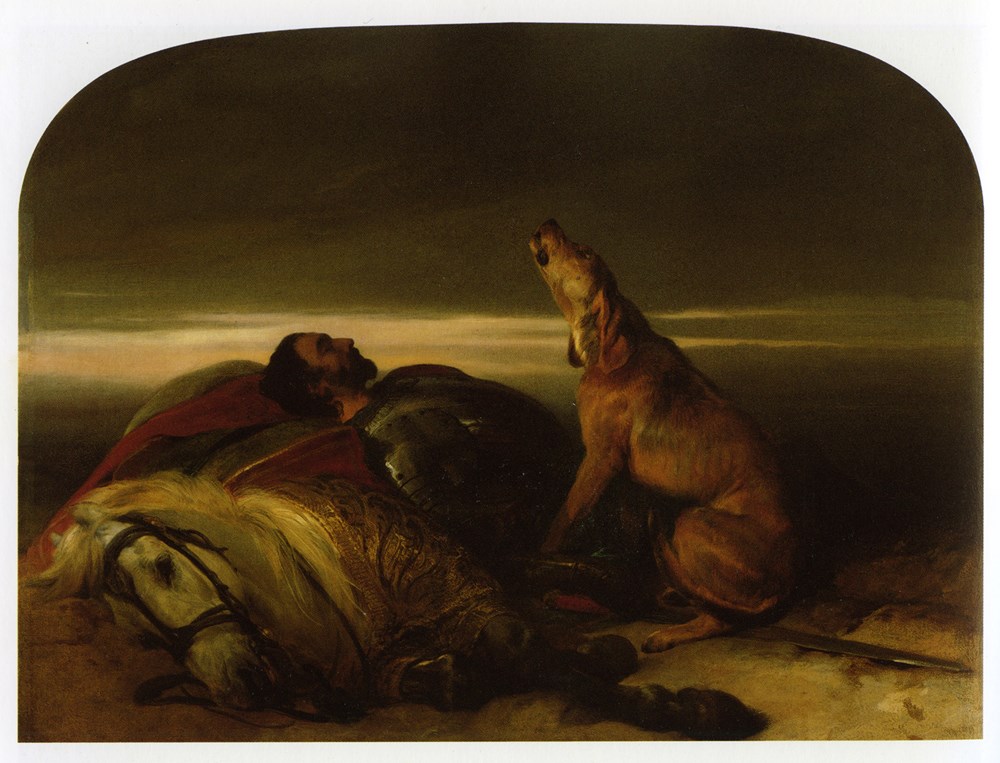
26 x 35 2/5 inches (66 x 88.9 cm)
Tate Britain, London
Fine art can deal with all or any of the seemingly endless arrays of feelings and experiences that benefit, excite, terrorize or plague humanity. This is the broader sense of the definition of “beauty” that we use in the aesthetics of fine art.
The artist is said to be successful, who can communicate some portion of human experience and do so with beauty, poetry and grace.
As with prose, poetry or theatre, there are subtle and nuanced ways to express ideas and feelings and to captivate and inspire one’s audience, or there are blatant, self-conscious, awkward, inane, childish attempts which fail as works of fine art, as well as en endless continuum of degrees of success or failure.
Often people ask how sad or negative subject matter can be beautiful.
The beauty is achieved by poetically communicating some aspect of the human condition with empathy so that the viewer/audience can relate to how it might feel to actually live through some unhappy or horrible experience. Or perhaps they have already lived through such an experience which evokes similar emotions.
The artist is telling a story that has strong meaning due to some aspect of their personal history.
The viewer says to themselves either consciously or subconsciously, “I know how you feel brother, or sister.”
Fine art helps people connect with one another and can even act as a pressure valve releasing tensions and can reduce the likelihood of conflict. Uncomfortable or unpleasant subjects may not be pretty but they can be very beautiful and we can learn from them.
Modern works with their indecipherable meanings can do the opposite: alienate and agitate us. Often Modernist works are praised for doing just that. Their stated goals are often to shock or insult.
Academically trained realist artists were accused of being elitist.
But what could be more elitist than saying “only we enlightened” can understand what Rothko, Warhol, De Kooning and Pollock were saying. If we don’t like it, they say: “You all are too ignorant, tasteless and clueless to get it.”
They call realist art simple and less sophisticated, because its meaning is too obvious and easy to understand.
In other words, if a work succeeds in the primary purpose for which it was created, human communication, that very success becomes the reason it is denigrated. The living realists of today as well as all realist artists of the past were expressing universal themes and reaching out to all people of all time.
We all have lives that include sadness and harsh realities; we all suffer loss and we all die. We all look to be comforted and we find comfort when communication takes place using the language of beauty, even when it deals with difficult material.
What is elitist? What could be elitist about that? Realist paintings of the past as well as those today are intended to bring humanity closer together. Nothing could be less true about all of the “isms” of Modernism.
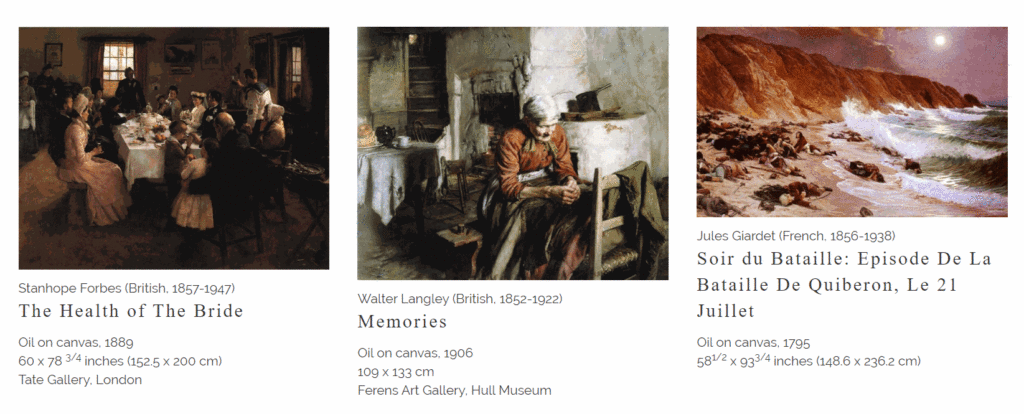
Let us once and for all put a spike through the heart of the Modernist argument that realism is trite, petty, inane, and devoid of meaning. For if that is true of technically skilled, Realism, then it would equally have to be true of all poetry and literature which also uses a vocabulary and structure which are recognizable by writer and reader, speaker, and listener; as it is too by painter and viewer alike.
In theatre the task at hand is whether the playwright, director and actors can enable the audience to “Suspend disbelief.” They endeavor to create a world in which the storyline of their play, or movie takes place. For this to work, the things that happen “the business” and the dialogue need to seamlessly work together in a manner that feels logical and believable. Even in magical realism, science fiction, and fantasy the goal is to make it all feel possible.
We all know that the movie or live show has been carefully written and orchestrated. Each word that is said, every movement the actors make, and each element of the set design, backdrops, and props that appear and are seen or used, have all been planned, usually down to the smallest detail.
The actors need to make it seem like they are saying their lines as if they were spontaneous responses to things that might be said in the situation or circumstance being portrayed. Indeed, some directors allow ad-libbing and extemporaneity from their actors to enhance believability.
But, careful planning is the underlying “truth” of what is going on.
For a theatrical performance to succeed as a work of art, it all must seem to be happening spontaneously as it would in real life. In that context, the writer can explore ideas about life that he or she chooses; whether it is about poverty caused by an indifferent or malevolent government or corporations, as seen in Grapes of Wrath, or the waste of life and the ennui and indolence that accompanies inherited wealth in The Great Gatsby, or the injustices and corrupt society and its effect on otherwise good people portrayed in Les Miserables.
All these books have been made into successful theatrical productions and films that can be said to have reached a level of fine art through the language of theater with its similar vocabulary and grammar of realism.
They have culminated in productions that suspend the audience’s dis-belief and they have each created their own unique forms of beauty.
In poetry, two good examples would be Omar Khayyam’s Rubaiyat, or Robert Frost’s Stopping by Woods on a Snowy Evening, both poems are about confronting death and characterize how to live one’s life, knowing that the grim reaper lies just over the horizon. These two poems use the language of words to deal with difficult subject matter in a beautiful way and all the images conjured are ones from our experiences in reality.
If the structure of the work of art is awkward or self-conscious, so that the details of how it is has been constructed is evident to the listener or viewer, the artist or author is thought to have failed. In theater, if the writing is fine, but the acting is terrible, then we might blame the actors or the director. But in every case you have the work of art constructed from elemental parts and assembled by the writer, director, composer, musician, actor, singer, dancer, painter or sculptor.
The importance in understanding this underlying process becomes very evident if we now look at the debate that has occurred between Modern art vs. Traditional art. The modernist artists who are credited with the origins of Modernism are celebrated for pointing directly at the underlying reality of what fine art is constructed from. Cézanne, Manet and Matisse we are told showed us the “truth” that a painting is really just colored paint applied to a flat canvas, paper or surface.
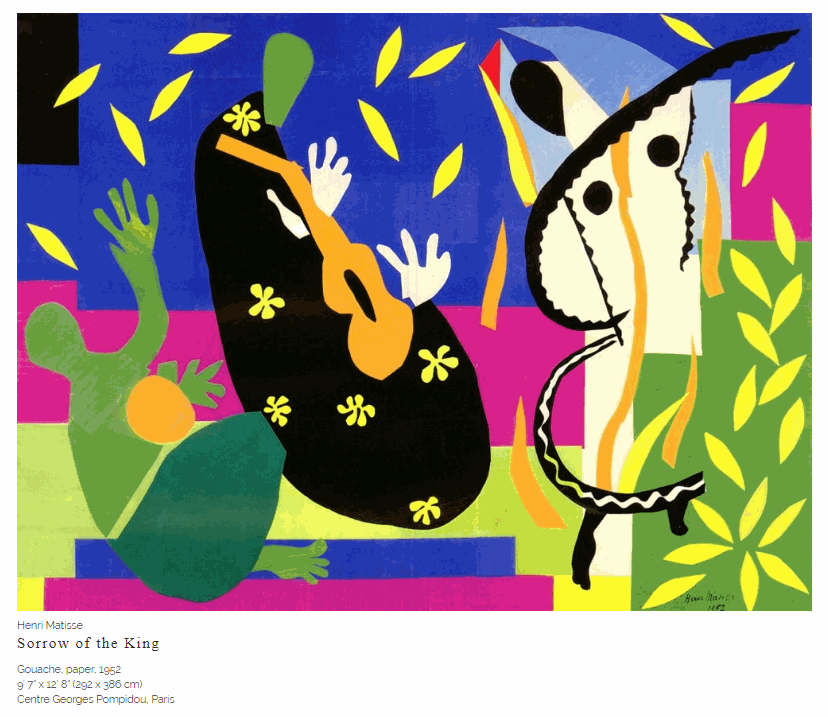
Modernism claimed traditional art, as taught in the art academies throughout the 19th Century, was engaged in lying to the public, trying to make the flat canvas look three dimensional; trying to use drawing, modeling and perspective to create illusions of space; trying to make you believe that you are perhaps looking into a room where people are doing something or at a landscape outdoors, etc. … all deceptions and lies. The job of the artist then, during Modernism’s 20th century ascendancy, was to make painting have value by focusing on the one aspect of what a painting was that no other art form had, which was the flatness of the picture plane. Focusing on the formal, underlying, fundamental components of art, became more important than focusing on why art existed in the first place, which was to communicate ideas, feelings, values and beliefs and all human experience.
Art's purpose was to justify itself, which ironically pretty much cancelled out all of its purpose and value.
Here is a quote from Clement Greenburg that makes this point:
Realistic, naturalistic art, had dissembled the medium, using art to conceal art; Modernism used art to call attention to art. The limitations that constitute the medium of painting, the flat surface, the shape of the support, the properties of the pigment — were treated by the Old Masters as negative factors that could be acknowledged only implicitly or indirectly. Under Modernism, these same limitations came to be regarded as positive factors, and were acknowledged openly. Manet's art became the first Modernist pictures by virtue of the frankness with which they declared the flat surfaces on which they were painted. The Impressionists, in Manet's wake, abjured underpainting and glazes, to leave the eye under no doubt as to the fact that the colors they used were made of paint that came from tubes or pots. Cézanne sacrificed verisimilitude, or correctness, in order to fit his drawings and designs more explicitly to the rectangular shape of the canvas. It was the stressing of the ineluctable flatness of the surface that remained, however, more fundamental than anything else to the processes by which pictorial art criticized and defined itself under Modernism. For flatness alone was unique and exclusive to pictorial art. The enclosing shape of the picture was a limiting condition, or norm, that was shared with the art of the theater; color was a norm and a means shared not only with the theater, but also with sculpture. Because flatness was the only condition painting shared with no other art, Modernist painting oriented itself to flatness as it did to nothing else. -Clement Greenberg , 19607
The truth was that there were no people, no landscape, no real objects to paint other than the concrete reality of the paint and the canvas. The artist, endlessly pointing directly to his underlying materials was the birth of Modern art.
Cézanne flattened the landscape, Matisse flattened our homes and families and the so called abstract artists after them, like De Kooning, Pollock and Rothko, put it all in a blender and threw it at us, thus making flat color design the end goal of the artist.
Expressing and communicating human emotions was not a worthy purpose for art, and so all human emotions were denigrated as petty sentimentality.
The equivalent of this system of thought applied to written languages would be to say that all writing is untruthful and finding the truth can only be discovered by pointing directly to the underlying materials and structure of written words.
All that is really there on the page are different shapes of straight or curved or squiggly lines. Since that is closer to the truth than placing meaning in those shapes and lines…than using them to make words and the words to form ideas … that too must be a lie and an unworthy purpose for the writer.
Therefore, to bring the analogy full circle … the best book would be one that demonstrates this “truth” with page after page of meaningless shapes and squiggles…thus showing us the modernist’s profound definition of truth. How many books and poems would be purchased and read in which all that could be found between the covers were meaningless shapes on every page?
Modernism endows the meaningless with meaning. Each of us must decide for ourselves whether there is meaning to be found and if that meaning has great value.
Is it petty and banal to show romantic or familial love and caring? Or is it petty banality to spend one's career insisting that the only paintings that have value are those which demonstrates that they are flat, or to focus as have the post-modernists on endlessly claiming to show the degradation of life via the degradation of art?
What then is fine art?
And for that matter, what is fine literature, music, poetry, or theatre? In every case human beings use materials supplied by nature (the clay, colors and materials of the earth and the movements and sounds of life) and creatively combine or mold them into something else which is capable of communication and meaning.
It is that ability to communicate, whether subtle or blatant, complex or nuanced and modulated wherein the value of art lies and makes it worthy of the term “fine art”.
Throughout history, people have found one way after another of communicating their thoughts, ideas, beliefs, values and the entire range of their shared experiences of living.
When it comes to the visual arts, modernists like to say “why waste your time doing realism? It’s all been done already.”
That would be exactly like saying “Why waste your time writing anything? It’s all already been written. There is nothing left to say.”
Illustration
Illustration is often thought of as a lesser form of art. Often we hear people say something like: “That’s only an illustration, it’s not fine art.” However, given the clear description of what fine art is, that no longer makes any sense. All fine art is illustration. What is different is what is being illustrated and then how well it has been accomplished.
If you look at illustrations in young children’s books, often those illustrations are done quickly and the cost and time involved in creating them plays a big role when writer’s or publishers choose them.
However, there are illustrations for books and poems which have been created by some of the greatest of artists. Gustave Doré illustrated Dante’s Inferno and Edgar Allen Poe’s The Raven. Edmund Dulac illustrated Edward Fitzgerald’s translation of the Rubaiyat by Omar Khayyam, and Michelangelo painted the Sistine Chapel ceiling with illustrations inspired by the Bible. All of the early and High Renaissance artists illustrated scenes from the Old and New Testaments. 19th Century artists illustrated Shakespeare, poetry and myths and legends.
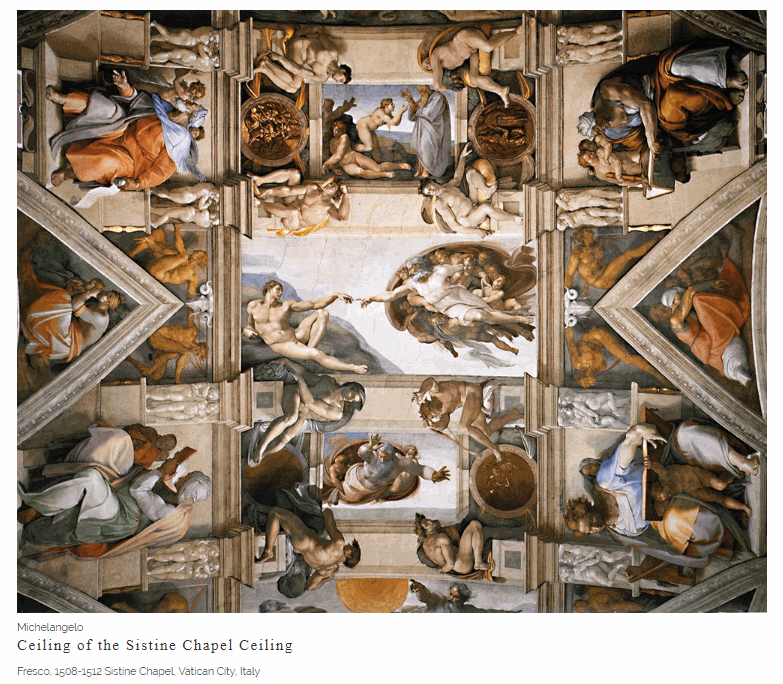
The attempt to pigeonhole images that tell a story as illustration which has been separated in many art schools as a lesser form of art is strictly a tactic to further entrench Modernist ideology.
Since all fine art is representational and since only realistic objects, figures and settings are capable of communication, one is drawn to the logical conclusion that all illustration belongs in the category of fine art. The differences are all qualitative: a difference in degree not a difference in kind.
Once we recognize that, we can see that variation in quality can be enormous and it may even be useful but problematic, to make an attempt to create categories along a continuum of some sort based on quality, purpose, and success or failure of the art and artist to communicate or illustrate what was intended.
There also can be qualitative differences in subjects and themes. Some themes are about more powerful emotions or moments during life that therefore have greater potential for achieving the beautiful. For example a painting illustrating wartime wives listening to a radio broadcast for the names of the men who were killed, has vastly more potential than a bowl of fruit or a painting of a can of soup.
Therefore, illustration and fine art are one and the same and all fine art illustrates something.

Originality
Let us talk now about modernism’s obsession with “being original”.
In any field of endeavor the idea “that it’s all been done before” places an impenetrable wall of hopelessness in front of any creative pursuit. Imagine becoming a doctor and not being required to learn what is already known?
Knowing doesn’t stop you from doing something new but it keeps you from wasting your time on searching for knowledge that already is known and readily available. It also decreases the chance of making very serious mistakes.
The refusal to learn from the past will inevitably prevent anything new from actually being discovered, as breakthroughs are always built on the discoveries of those who came before. In the arts, the fear of doing what has been done before places a ball and chain on your mind and on the joy of creativity, one of the greatest joys in life.
Only someone who has learned what is already known can strive to create fearlessly and will have any chance of actually creating something new. For invariably, humankind has a history of creative accomplishments going back thousands of years, so someone who is creative will surely stumble upon many things that have been thought of and done before in advance of achieving the truly original.
And if we are honest, the most favored subjects are as old as humanity itself and there are unlimited and original ways in which they can be expressed again and again.
Modernism in its need to banish anything seeming unoriginal, has banished all of the tools and skills with which original work was accomplished and then tells their artists without skills and without tools to go and create worthwhile works of fine art.
Since there is no meaningful language in their art, a thousand words are needed to imbue it with meaning. Actually the words have to be incredibly creative and shrewd to convince otherwise educated and intelligent people that something of value is present when little or nothing is there.
Modernists create art that is about art: “art about art,” whereas all the great art of the past was “art about life”.
A painting should no more attempt to make the viewer conscious of the paint and canvas than the writer should make the reader conscious of the ink or type of paper being used, or for that matter than the film maker should make the audience endlessly aware of the kind of cameras being used or that the movie is actually composed of a fast moving series of still images.
The resurgent realist artists whose ranks are rapidly expanding in the 21st century, consider their materials and skills as a vital means of communicating artistic subjects and ideas. Modernism banished the real world from the tools they could use. Of course, without the full vocabulary of the real world to draw and to draw from, the only way complex ideas could be presented to us by modernism is if people “in-the-know” explain to us what ideas were intended and then required us to believe it.
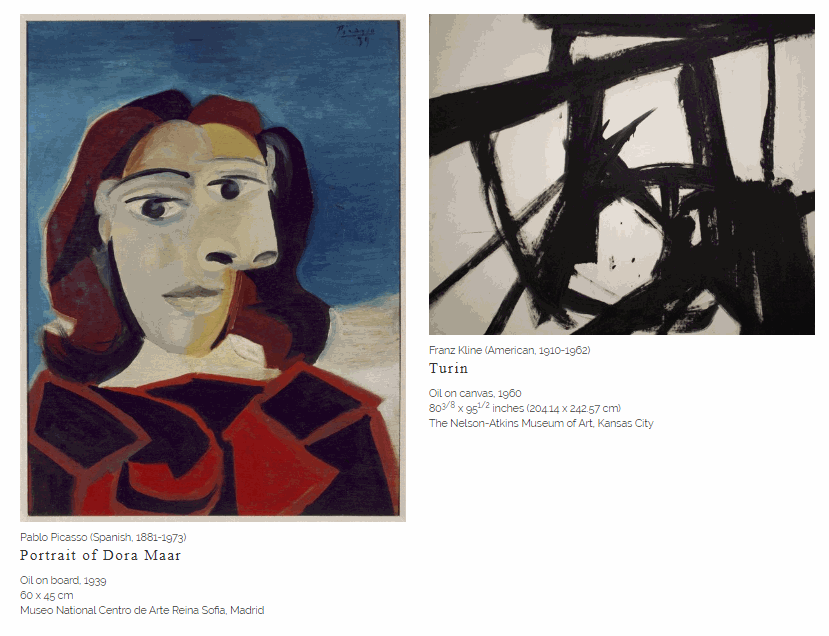
Franz Kline’s harsh slashing black lines on a white ground, we’re told, represents how harsh life is and Picasso’s distorted human forms are meant to represent how distorted society is and how psychologically malformed mankind has become.
Now, once we have been told that’s what he means and that’s what he’s doing, if we’re ready to be one of the savvy, then we can start to see it.
Perhaps accuracy is better served if we realize that we had better see it if we don’t want to suffer derision and ridicule by the ruling cognoscenti in today’s art world?
They say that modernism created a new way of seeing.
Or is this new way of seeing really just pointing out the painfully obvious. Even if we give them some benefit of the doubt that someone needed to point out that the canvas was flat, how many times does it need to be proved? After all, any three-year-old who is taken to a museum knows that the canvases are all flat.
How great then was it that Cézanne and Matisse spent the rest of their careers saying it over and over again?
Or perhaps we should not give them the benefit of the doubt? Did it really need to be said and did it really need to be then taken to the extreme of abstract expressionism? Which, by-the-way, is neither abstract nor expressive.
A blueprint is an “abstract” of the layout of a house or how the electrical system will be installed or it shows the footprint of the house in a carefully drawn representation of the piece of land it’s to be built upon.
The word “bottle” when spoken is an abstracted representation of the object that can hold liquids. The written word bottle is a further abstraction of the spoken word. A painting of a bottle is another abstraction of that object and the more it looks like a bottle the more accurate the abstraction becomes.
So the word “abstract” means the opposite of how it is used by Modern art and their apologists. Realist paintings are accurate abstractions of ideas, events and an endless number of other possible subjects.
Globs and dribbles of paint on a canvas are actually quite concrete. They are the end product: a glob, a smear or a dribble of specific size and shape which has no other meaning besides what it is and clearly is expressive of nothing at all.8
Is there any need in these abstract works to suspend disbelief? No, that would be a lie by their definition. Or is “belief” instead compelled, not by the acting, writing, drawing or painting, but instead by the intimidation of power and position?
Prestige Suggestion
Do students believe in this new inheritor of Western Art? Or does not believing in it threaten their grades and positions (and the wallets of those invested in such art.) It is amazing how the need to avow one’s belief repeatedly in something that was previously difficult or impossible to believe, will become increasingly easier when supported by figures of authority. A useful term for this phenomenon is “prestige suggestion.”
What Modernists have done has been to aid and abet the destruction of the only universal language by which artists can communicate our humanity to the rest of, well, … humanity. They then have built up a labyrinth of justifications and blocked all other viewpoints. If the history of what actually took place is not to be lost due to the transitory prejudice and taste of a single era, then we must question any practice that deliberately suppresses documented evidence.
Art history must not be reduced to little more than propaganda directed towards market enhancement for valuable collections passed down as wealth conserving stores of value.
Successful dealers, who derived great wealth by selling works created in hours instead of weeks, had little trouble lining up articulate, eloquent and persuasive masters of our language to build complex portrayals presented everywhere as brilliant analysis to justify what are really very uncomplicated, unsophisticated and simplistic works; creations which arguably should have and would have been rejected out-of-hand but for their ingenuous sophistry, expansive jargon and artfully cunning patois.
Any time people or brands or logos become the symbols of quality, value or expert authority, then other people when presented with those symbols will see quality, value or importance regardless of what is actually there.
For example, a wealthy consumer will see a purse with the name “Prada” or “Gucci” on it and will automatically assume value and quality.
Perhaps the price will be $5000 and if it’s on sale for $1200 they’ll believe they got a good deal and be proud to wear it or show it off to friends. Take the same bag without a label and try to sell it on a table on 42nd street with an $80 price tag and the same person may think it’s over priced and will try to talk the price down perhaps to $40, or not buy it at all.
The Prada name and the fact that it’s being sold in Bergdorf’s or Bloomingdale’s tends to give it the prestige and assumed value which has been suggested into the mind of the consumer.
Many years ago I took my son on a class tour they were giving at a General Motors assembly plant where we witnessed the assembly of a Chevrolet.
Then another identical car came down on the same production line and they placed a different grill and hood ornament on it and labeled it Oldsmobile. A third identical car came through and they put a still different grill on it with a label calling it a Cadillac. Nearly everything about it was the same, but the Cadillac brand was double the price of the Oldsmobile and the Olds was selling for a third more than the Chevy.9
There is a difference between value due to prestige suggestion and value due to intrinsic quality.
Surely, in the search to define beauty, we need to understand that difference. We should be able to see through prestige and determine when we are in the presence of the truly beautiful, versus a work that’s the greatest quality is the prestige attached to the name of the artist or the movement.
In this way a canvas with little intrinsic value that has the signature of De Kooning, Pollock, Rothko or Mondrian on it, are assigned high values because people with a PhD or the title of Professor or Museum Director next to their names have told us what to think about their worth.
Then, major dealers or auction houses have assigned estimates of millions of dollars to their work. Most people do not feel themselves knowledgeable enough to know what has or does not have value, when it comes to pocketbooks, Persian carpets, or wristwatches, and much less so with works of art. This is “prestige-suggestion”. Even if their instincts are to reject something, they keep silent lest they expose themselves to ridicule for being considered ignorant, tasteless or out-of-touch, succumbing to “social pressure”.
Art-Speak
There is a second very useful expression identified that aids us in understanding what has occurred and how Modernism, after gaining ascendance, has been able to maintain its position.
That term is called “Art-speak”. Art-speak is a contrived form of language, which uses self-consciously complex and convoluted combinations of words to impress, mesmerize and silence opposition.
“Art-speak” is generally used by people in positions of power and authority and in combination with “prestige suggestion” is ultimately employed to silence contrary instincts and ideas to prevent people from identifying honestly what has been paraded before them.10
This is accomplished by brainwashing society through authority and confounding, with “art-speak”, the evidence of our senses about objects and ideas that otherwise any sane person would question.
The “authority” of high positions, and the “authority” of books and periodicals, and the “authority” of certificates of accreditation attached to the names of the chief proponents of modernism, which have all worked in combination to impress and humble those whose common sense would otherwise rise up in opposition.
Without a doubt they would clearly see this art for what it is, evident nonsense, if it’s supposed value had not emanated from the pretentious mouths and pens of those with such a preponderance of “authority” to back them up. Many students and even teachers have come forward to report how traditional realism has been virtually or actually banned from their art departments. They want to share their sufferings at the hands of Modernist educators, and ask what they can do.11
Banning of ideas and not permitting free and open debate has been a problem throughout history. Most often relating to religion or politics it rears up in other fields as well. For example, global warming is often taught as settled science with the suggestion that only fools would listen to arguments questioning it despite mountains of conflicting evidence. John Stuart Mill’s remarks on speech suppression are as alive and accurate today as they were two hundred years ago:
Where there is a tacit convention that principles are not to be disputed; where the discussion of the greatest questions, which can occupy humanity, is considered to be closed, we cannot hope to find that generally high scale of mental activity, which has made some periods of history so remarkable.
And:
However unwillingly a person who has a strong opinion may admit the possibility that his opinion may be false, he ought to be moved by the consideration that however true it may be, if it is not fully, frequently, and fearlessly discussed, it will be held as a dead dogma, not a living truth.
John Stuart Mill's essay "On Liberty"
from Great Political Thinkers by William Bernstein, p.569
Without a dynamic living network of experts teaching technical knowledge in drawing and painting, it will never be possible for college and university art departments to have students who are able to enrich the debate and the academic environment for all students by producing works of art that are capable of expressing complex, vital and spirited ideas.
To forbid these skills to be taught on campus in any real depth is as ridiculous as having a music department that refuses to teach the circle of fifths or only teaches three or four notes from which they insist all music must be composed. It is as absurd as having an English department in which all words that had recognizable meanings were forbidden and only writing without words or sentence structure would be admissible.
If there was nothing to be ashamed in their teaching methods and in their results, they would welcome the chance to confront the ideas that they should be well equipped to refute.
They have a solemn duty to maintain the integrity of thought made possible by what has been handed down to them by those artists, writers and thinkers before us, who established a vast, complex and rich system of training with which to teach and pass on a wealth of knowledge.
Deliberately preventing access to this information is crippling to the goals of education and a severe obstruction to insuring a society based on freedom of thought without which progress is impossible. Where is it more important to vouchsafe these principles than at our nation’s colleges and universities who are training the next generation of leaders? Even if they don’t agree, they have a duty to expose their students to responsible opposing views in all fields and disciplines.
While it is beyond the scope of this chapter to fully delineate the evidence and arguments on both sides of the Modernism vs. Realism schism in fine arts and aesthetics, for the purpose at hand, we are focusing on the realist position which in recent decades has had very few proponents, ceding nearly a century to an ascendant modernist leviathan. And that century has seen the greatest strides forward in every other field of human endeavor. If the proponents of realism are as correct as it seems, the art world is woefully behind our times and will need to do a lot of catching up.
Relativism
Modernist theory, as we’ve seen, looks to redefine the purpose of painting by means of:
- Elevating the flatness of the canvas or the medium as the primary subject,
- Explaining the transcendent value of their work with art-speak,
- Maintaining their ascendant position with prestige suggestion.
Yet there is another underlying idea that propels the Modernist hegemony. Simply stated it's called "relativism" which is at the heart of Existentialist philosophy.
To this end, one hears employed several popular maxims. These sayings are then used for the purpose of contradicting the whole notion that one can actually define or describe either fine art or what is beautiful. The modernists then often rely on distorting the meanings generally ascribed to these expressions to help establish the value they then ascribe to modernist theory and the products created in their service, which are offered up as fine art.
- There is nothing good nor bad but thinking makes it so (William Shakespeare.
- Beauty is in the eye of the beholder.
- One man’s meat is another man’s poison
These sayings have all been used over and over when it comes to the concept of beauty and aesthetics.
When taken to the extreme in the visual arts the implication is that no matter what the object is, whether it is art or for that matter anything else, there is no way to gage good from bad, right from wrong, beautiful from ugly or elegant and graceful from ungainly and awkward.
All that matters is that nothing matters. Therefore there can be no judgment or assessment of quality. This concept makes aesthetics unimportant. If everything’s value is a matter of opinion, than why discuss it? Everyone is right; which is the same as saying nobody is wrong. It is clear that this cannot be true. So many throughout history have taken so much time in trying to define what is beautiful and to differentiate between good and bad aesthetics and perhaps even more important, between what is right and what is wrong; a dilemma that confronts us constantly every day of our lives.
Stated simply, in the visual arts as in all the other arts and in all other fields of human endeavor, it is necessary and important to be able to make judgments. Yes, to judge, and use words of judgment that has been deemed in many classrooms and philosophies as inappropriate. How could understanding goodness, beauty and truth be inappropriate?
Behind the wish to ban judgment is “political correctness.”
Political correctness worries that if one person is doing well than it must mean that someone else is doing poorly. If we celebrate accomplishment, we must then acknowledge failure; which means someone will feel badly or will feel inferior.
One common solution for this reality is to point out that different people are good or better at different things and worse at others. But no matter how much we don’t like it, the truth is that there are also some people who are good at nearly everything and others who are not good at nearly anything.
Fortunately, most people do have some talents that can be found. The upshot of trying to avoid and run from the truth (that there is good and bad, better and worse) is to force everyone to value and function in mediocrity.
There are few things more depressing than that. We’ve all heard of some schools banning grades and competitive activities like spelling bees and even some sports. How likely will their charges be made ready to compete in the outside world after graduation?
The way to help people who have special needs or who are born with less skills and talent should not be by limiting possibilities to succeed and achieve for those who have great talents and the work ethic to see them actualized. Brilliant achievements are unlikely to come from a society that refuses to recognize great works.
Political correctness is a bit of a tangent, but like Modernism it sees the world through relativist lenses. All three of the popular phrases listed above, are succinct ways of expressing a belief in “relativism.” There is no good and no bad; no up or down. All things are relative to circumstances and position and the ultimate expression of this philosophy, called “Existentialism” is that “There is no truth”, and if there is no truth there is no beauty nor goodness. There are no absolutes of any kind.
Of course the true believers in the absence of truth are always unable to explain the obvious paradox that the statement “There is no truth” is itself a statement of what they “firmly” believe to be the truth. It’s very similar to the paradox always discussed in logic courses which revolves around this avowal, “This statement is false” If it is true than it must be false and if it is false it must be true.
It’s a circular argument that goes nowhere fast.
Despite the frequency with which we hear this, it is also clear that nobody really believes that “there is no truth.” The simplest way to prove that someone does not believe it is to ask them if they would place themselves or their families in the middle of a major highway during rush hour. Would they bite into a light bulb or wear a shirt whose collar was made of razor blades or jump off the roof of a skyscraper?
It’s really just hubris to claim there is no truth when everyone every day in a thousand different ways all people demonstrate that they believe in the truth and that they believe that some things are good and other things are bad.
There may be categories of things for which people can have differing opinions as to their relative values or dangers, but there are many…very many things that people believe in absolutely.
The very fact that they are there telling you there is not truth proves they believe in many things including the fact that you are a different person from them and that they can communicate to you using a common language and that the words have recognizable meaning.
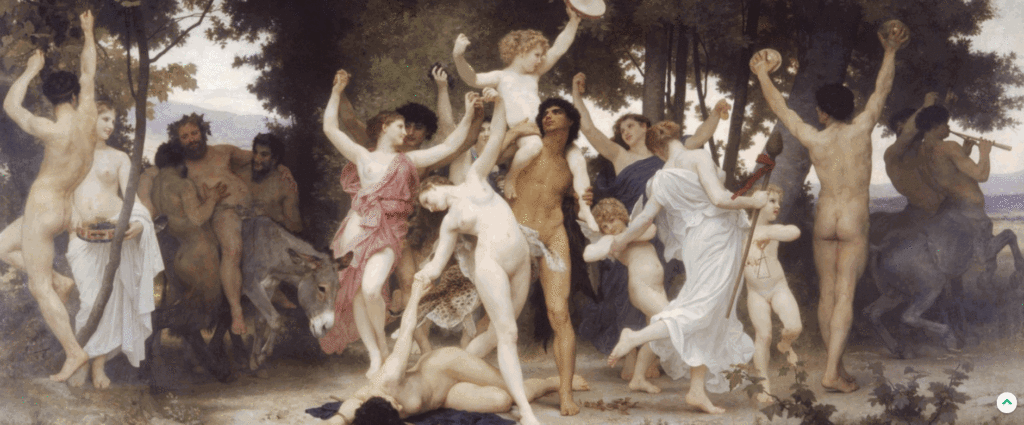
432 artworks
French Academic Classical painter, teacher, frescoist and draftsman
Born 1825 – Died 1905
They believe that they can speak using their mouth and that people have ears and brains with which to interpret what they say.
They believe that the sounds they make when they speak can go through the air and they believe pretty much in what they see around them. I hesitate to now point out that those common phrases are somewhat true and have their use depending on what is being discussed.
For example, “beauty is in the eye of the beholder,” can be accurate in a circumstance where we are reviewing different things in the same category. To then say beauty or goodness is relative of one to the other will make sense. I prefer chocolate ice cream, my wife prefers coffee, and my daughter vanilla.
But all people will prefer ice cream to arsenic. There is no relative benefit between those choices for human beings everywhere. It’s an absolute: arsenic is bad and ice cream is good.
Modern art seems to especially need these existential phrases as the raison d’etre for their “anything goes” mantra. However, if everything is art, than nothing is art. Relativism has led to “production” by some artists of things like blank canvases, empty rooms and piles of garbage, for which some of them have been celebrated as geniuses by Modernist art critics.
The Turner Prize recently was an empty room with the lights going on and off every five seconds. 12 Another year the award went to a pile of excrement. 13
It’s hard to even have to say it.
Realist philosophy would pretty much deny the credentials of such critics a priori since they are rejecting all of the basic parameters of what constitutes fine art. If we think about it, relativist existential ideology is at the core of all Modern art, and these artists are celebrated for work that is seen to articulate the idea that there is no good nor bad, no truth and basically no beauty as well.
So I ask you how can a belief that there is nothing beautiful be the driving force to create beauty?
All human sentiment, which is regularly belittled by calling it sentimentality, is rejected by existentialism. Another word that describes much of the philosophy of modern art is “nihilism” which believes there is no meaning in life. Their art is a continuous stream of celebrating the absence of value and thereby all of the preferences and desires of humanity.
The ultimate hypocrisy is that they then shower accolades, riches and fame, upon those whose art proves that nothing has value, paradoxically ascribing great value to it.
It was inevitable that intelligent people would eventually identify the duplicity of this central underlying contradiction.
Said another way, modernists ascribe great value to proving everything is worthless.
As I have shown, we can readily prove that nobody actually believes that nothing has any value. It’s patently false. If it is false that there are no truths, then there must be truth; there must be good and bad; there must be value and importance in human sentiments and feelings; there must be value in communication between people and the forms of communication, which document and preserve our shared humanity. Therefore, there must be value in all of the fine arts, and for our purpose today, there must be value in traditional realism.
I feel it’s important here to go back to “art speak” and “Prestige Suggestion” and show an example of how they sounds and work.
As discussed, Modernism, in order to buttress the value of what it produces, employs experts at “art-speak” who articulate and promote modernism by the use of complex esoteric verbiage, which project an aura of value and importance onto objects that are clearly bereft of any sophistication. Imagine reading a review by a food critic expounding on the virtues of Jell-O.
You are first told how this critic graduated the Culinary Institute with honors and travelled the world to learn about every kind of cuisine.
He writes for the New York Times and has a TV show on food with a big following. Then, after learning about his credentials, the first review you read by him is about Jell-O, which he praises as great American cuisine.
The Jell-O, he goes on to describe, is a perfectly nuanced colloidal melt-on-the-tongue stasis boiled to the moment of perfection when a moment less would tend it towards sineresis 14 and a few seconds longer would allow the jell to become too stiff, clearly showing true mastery of the chef’s use of vacuum pans and rare Bavarian rapid set pectin.
Clearly the chef who created this delicate sensation must have used a double boiler for modulation, with a deft control of vacuum reduction.
It’s all reminiscent of the finer aspects served by Wolfgang Puck or Gordon Ramsey. Surely a search of seven continents had produced the finest mix of simulated strawberry piquancy, capturing the eloquence of deep red Tudor and delicate Nova Scotia Wild straws.
Taking my tongue out of my cheek, how much experience and education does one need to reject such nonsense out-of-hand? It’s Jell-O you’re being shown, which to many has considerably more actual value than a canvas with paint flung at it.
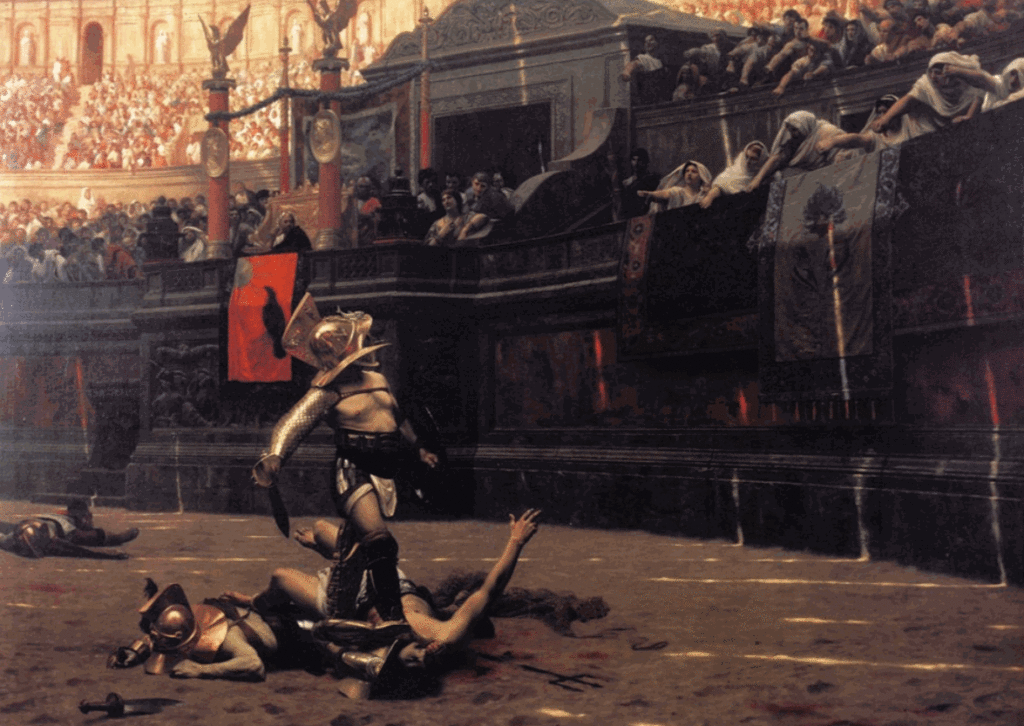
1824-1904
Orientalist painter, draftsman and sculptor
Pollice Verso
Thumbs Down
And yet, the art world is filled with far more flagrantly absurd objects praised in ways which might be described as a convoluted quandary wrapped in an enigma and embedded in a paradox. “Art speak” generally demonstrates far more creativity in the writers who write it than it does in the artists whose product they have, described, explained and justified.
Modern and postmodern works, absurd, nonsensical and mind-numbing, have taken control of the world’s formerly great art institutions. One can’t help but bring to mind echoes of infants playing with their own excrement. It seems, the simpler and more naïve the creation, the more sophisticated it’s purported to be.
Barnet Newman’s huge canvas, from what is considered the high point of Modernism (1950’s and 60’s), is called Black Fire 1. It sold for an incredible $84,000,000, this past June, 2014. Here’s what the auction house’s specialist said about it; clearly far more masterful at art-speak than Barnet Newman is at painting:
Black Fire I is a sublime Abstract Expressionist masterpiece that perfectly captures Barnett Newman’s radically reductive and uncompromising aesthetic.
The Zen-like simplicity of Black Fire I embodies the spirituality, grandeur and solemnity that define all of Newman’s greatest works. Painted during a period of refrain after suffering the loss of his younger brother, Newman negotiated his emotions through the language of abstraction.
Continuing the dynamic tension between light and dark that was first established in the Stations of the Cross, the composition of Black Fire I exhibits a similar weighty sense of the absolute.
Through creating the Stations of the Cross, Newman had chosen to reject the allegorical distractions of color in order to create a pure, distilled emotional statement through the subtle nuances of spatial relationships and expressive brushwork alone.
Newman’s decision to place black pigment on raw canvas gave way to Black Fire I and it was this deliberation that allowed Newman to communicate, at the highest degree, the universal dualities of existence: light and darkness, creation and destruction, form and formlessness.
Black Fire I holds an important place within Barnett Newman’s oeuvre, having resided in several distinguished American collections of modern art. It was featured in two important international group exhibitions shortly after it was created.

It is nothing more than a canvas half beige and half black with another black line going through the beige portion.
Art history courses in nearly every university and college in the world are likely to have staff members ready to praise this canvas unabashedly, and thousands of students, many whose instincts tell them how absurd it is, have in recent decades had to shrink back fearful of the ridicule they’d receive if they gave voice to what they really thought.
Of course after a long series of courses, lectures and books filled with “prestige suggestion” and “art-speak” and without any exposure to responsible opposing viewpoints, many of them start to convince themselves of what is not there.
Before long black is white, up is down, and nothing is something.
Ultimately there is a kind of religious fervor associated to this system of thought. If Modern art is so great, if blank canvases and splattered colors have so much meaning, why do they need the most complex and sophisticated language to imbue meaning into them? Thomas Wolfe saw through this decades ago when he published his book, The Painted Word, in which he basically expresses the same idea, that Modernism relies on the most sophisticated and advanced kinds of language and ideas to justify objects which clearly have no intrinsic value.15
We’ve all heard that a picture is worth a thousand words. When we look at a Rembrandt , Michelangelo , Bouguereau or John Singer Sargent we are awed by the inherent beauty and we then consider what we are feeling and try to find the right words to describe it.
But with Modernist works by De Kooning, Pollock, Miro, Mondrian and dozens of others, clever critics, who are really just language manipulators, have built up ever more tortuous vagaries and conjured imaginings, layering their silver tongued alchemy, one sentence after another onto these “creations” which they proclaim as iconic, platinum and gold; when even lowly lead is missing. A new generation is now seeing blatant instead of brilliant; ingenuous not ingenious and sophistry not sophistication.
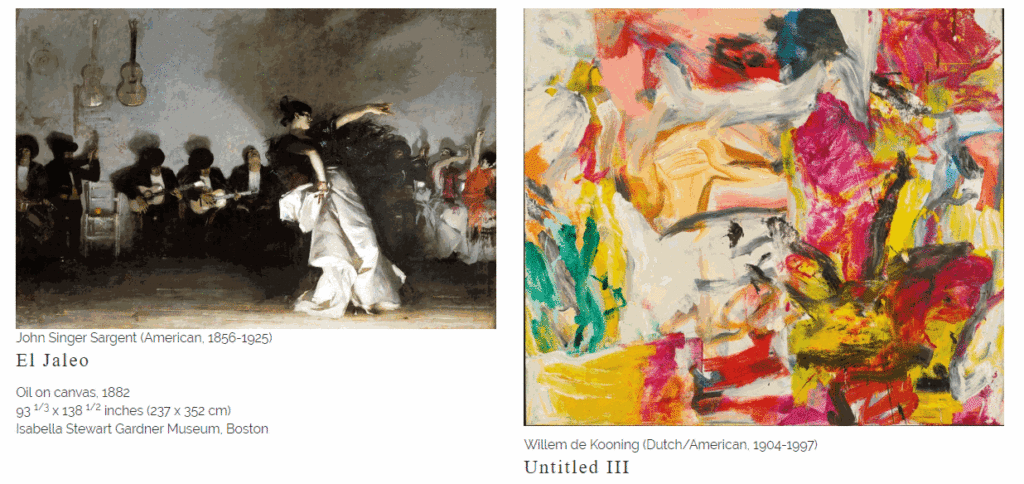
If the macro story of humanity and the micro story of individuals are sentimental and unworthy for artists, then what is a fitting purpose for modernist and post-modernist philosophy?
What is relevant? They will tell you: ‘form for its own sake” … “color for its own sake” … “Line or mass for their own sake.” That is art. There is nothing else that art should communicate or express. As if line, mass and color have wants and needs and an independent purpose of their own. They say they’re showing us how to see differently, but if we are true to ourselves, we all see what’s there and more-so what is not there. Clearly, “the Emperor has no clothes.”
To the Modernists these abstract or minimalist canvases are far more worthy of accolades of merit than recreating scenes from the real world, or from our fantasies, myths or legends; more profound than imagery which shows our hopes, dreams, and the most powerful moments in life.
Blank canvases, or empty rooms, or a mound of rocks are more “relevant” subject matter than the times during life that are most memorable, which describe and define our shared humanity. Simple shapes of color are preferred to subjects about people of color; strata of textured paper trumps showing the textured strata of life.
Dribbles of paint are more compelling than a child learning how to dribble a basketball. Piles of garbage are considered more sophisticated than showing the transition from self-conscious adolescent to self-assured adult; and a light blinking on and off in an empty room attracts journalistic praise, while the blinking passage of life and time are but worthless sentimentality.
These are the ignorant precepts of the prefects who hold our museums and college art departments in a hundred-year long grip of meaningless irrelevancies; boring us and our youth alike in a system where the highly skilled are scorned and the talented are passed over and disillusioned. The true artistic masters, until very recently, were dying off without a trained generation to protect, preserve and perpetuate that which had been preserved for so many centuries before.
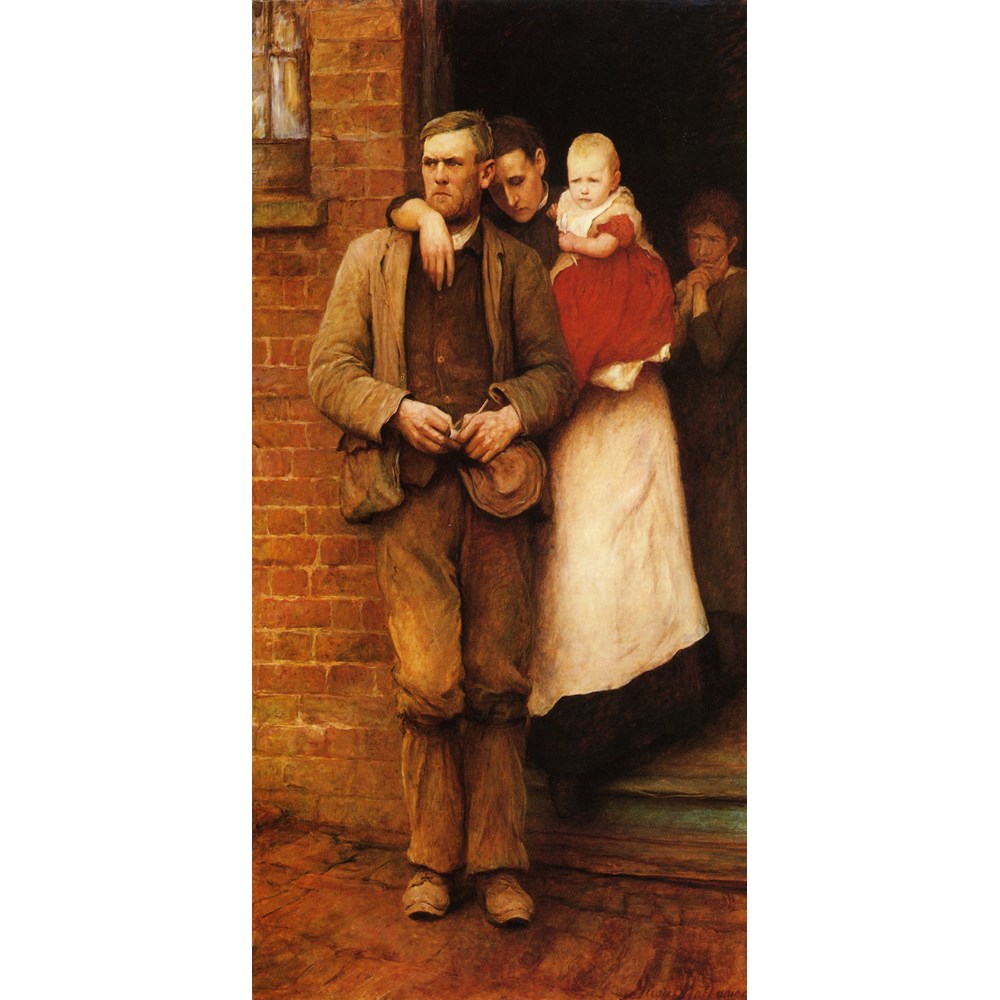
89 3/4 x 49 3/4 inches (228 x 126.4 cm)
Collection of the Royal Academy of Arts
Modernism shakes its fist at the realist artists of today and the academic artists of the 19th century, claiming that their focus on the development of skills leads to constraining true creativity. They heap adulation on any artist who is focused on throwing off one or another of the definitions and parameters of classical, academic art, all of which are viewed as restrictive and limiting.
The sad irony is that Modernist ideology is far more restricting and limiting to creativity than any of the art and movements that came before it, or the new realist movement that has emerged today.
Artists have been virtually (if not actually) imprisoned; whether we are talking about the chained constraints of “conceptual art,” or the drudgery of “deconstruction,” the “shackles of shock”, being mired in “minimalism,” or the vapid, inane impoverishment of works described as “abstract”. All are chains which have been “forged link by link and yard by yard”, paying lip service to composition and design, having long ago abandoned all of the parameters of fine art; but especially the paramount need to harmonize great subjects and themes with drawing, modeling, perspective, color, tone, and the expert manipulation of paint. And what are these subjects and themes?
They are the ideas, values, beliefs and the endless range of human thought, feelings and experience.
19th Century Overview
In order to understand the need and search for beauty as indispensable to an artist’s compositions and choices of subjects, we need to see how that quest for beauty and the academic skills and techniques needed for artists to realize their creative ideas, were employed by the last generation of artists who believed in their critical importance: those of the late 19th Century. To state it another way: to comprehend how Modernism gained ascendancy for so long, we need to describe what the artists before them were actually painting and why. How did skill-based Humanist art fall into such decline?
Without any doubt, the art world of the past century has seen a relentless effort to malign and degrade the status and the reputations of the artists and their artwork produced during the Victorian era and its equivalents in Europe and America. Their success in doing this had been nearly total by the end of the Second World War and continued nearly unabated and unopposed until the 1980’s.
It continues in most ways to the present day. But, in the past thirty years it started to change, very slowly at first, but clearly picking up considerable momentum since the end of the millennium.
I tend to think of 1980 as the first beginning of this change in attitude, when the Metropolitan Museum took some of their finest academic paintings that had been in storage since World War I and hung them in the new Andre Meyer Wing announcing their decision to the world and suffering considerable editorial drubbing by famous critics in major newspapers.
Hilton Kramer of the NY Times led a widespread journalistic assault accusing the museum of taking corpses from their basement and excoriated them for daring to hang William Bouguereau and Jean-Léon Gérôme next to Goya and Manet .16
That was when voices who supported the Met’s actions started to be heard even though they had been trying to be for years before.
Over the past three decades, art historians have done a great deal of research and found an overwhelming preponderance of the evidence that shows that the modernist descriptions of this era are no more than misinformation and distortions fabricated in order to denigrate all of the traditional realist art produced between 1850 and 1920.
Amazingly, Emile Zola wrote a novel called The Masterpiece (L’Oeuvre): a fictional account of how Impressionist painters were mistreated by the official academic masters who ran the Paris Salons. This totally made-up account of what occurred was then used and written into most art history texts as if it had actually occurred.
For example, in his story The Salon de Refusé was formed due to a public outcry over the rejected impressionist artists when it actually was the brain child of Napoleon III who felt sorry for the mostly academic artists who walked out of the Salon lead by Meissonier who was famous for his precise cabinet and military paintings. To this day the heart of Modernist accounts of the art history between 1850 and World War I are based on this work of fiction.
The truth was very different.
Impressionism showed up in the Paris Salons nearly as soon as it appeared in the art world. They never suffered a tiny fraction of the suppression that realist artists actually have experienced in the 20th Century. Much of it has been conceived as retribution for what the Impressionists supposedly endured at the hands of realist academicians.
The only problem is that the original causal events never happened and even if they had, the current realist artists couldn’t possibly have had anything to do with it. The information presented here suggests far more profound and underlying core reasons why this should never have happened and why it needs to be reversed.
The suppressed truth about the fine art of the 19th century is that it was a time of explosive artistic activity unrivaled in all prior history. Thousands of properly trained artists pouring out of the great academies and master ateliers throughout the western world developed a myriad of new techniques and explored countless new subjects, styles and perspectives that had never been done before.
These new works covered nearly every aspect of human activity. They were the product of the expansion of freedom and democracy with a profound respect for life, for humanity and for individual human beings, including their minds, their souls and their boundless creative potential. They helped disseminate the growing view that every individual was valuable, that all people are born with equal inalienable rights; especially the rights to life, liberty and the pursuit of happiness.
The artists and the writers of the 19th century identified, codified, protected and perpetuated the great humanist values and momentous Age of Reason discoveries of the Enlightenment.

Relevance
The writers from that era, such as Honoré de Balzac, Victor Hugo, Mark Twain, and Charles Dickens, have been widely praised and celebrated, while the artists of the same period, communicating the same concepts and values … in stark contrast … have been mercilessly ridiculed and slandered.
Working together, their generation played a direct role in helping to free the slaves, in bringing into awareness the damage the industrial age was doing to the environment, in bringing public outrage to child labor and unsafe working conditions, and implementing the process that would lead to equal rights for women and their right to vote.
Their work laid the foundation for breaking up monopolies, protecting and assuring minority rights along with a nearly endless list of societal improvements. The modernists point to the fact that in the 19th century, these things needed to be changed, claiming it was a repressed society.
In truth, all these injustices had been going on for centuries and all of human history before. But the 19th century was the start of the evolution that transformed society into the modern era. It was a society emerging from repression and oppression. Their developing self-awareness led to implementing all the forms of freedom we now take for granted: and history rarely gives the artists any of the credit.
The writers of that time who described this period are today widely celebrated. The visual artists were addressing the same things as the writers and for this incalculably supreme accomplishment their recompense, has been for a century to dismiss their work, denigrate their technical skills, lie about the significance, meaning and importance of their subjects and to totally berate them and their achievements.
Why?
Because they didn’t lead the way to splattered paint, blank canvases or industrial size soup cans? They didn’t believe that proving the canvas is flat was the most important subject for fine art? Therefore they were all branded as “irrelevant”?
Here we have a primary concept used by modernists, “Relevance”. These widely beloved 19th century artists are not considered “relevant”, and if they are not relevant, certainly today’s realists are even less relevant. Only works and techniques that shed all the former definitions and parameters of fine art were considered “relevant”. Only those artists that lead the way to abstract expressionism were worthy and “relevant”. Nothing could be further from the truth!
As described above, the purpose of fine art is to communicate. It is successful if it explores the human experience, with poetry, beauty, and grace. If it is unskilled, awkward, and self-conscious, it fails.
Therefore, to say that the realistic movements of the 19th Century were irrelevant to their times or to the major path of the fine arts through the ages, is utterly wrong and incorrect. They were, in fact, at the pinnacle of five hundred years of growth and evolution of their chosen field and had an incalculable impact on the social reforms that were to follow them.
Even the symbolist movements of the 19th century was using modern concepts of psychology before the psychologists. 17 The modernists took art in a completely different direction.
It will be for future generations to determine if that new road was important and meaningful or a dead end in which future progress within their genre was impossible. There are those today who believe it can only be saved by finding a way back to the place where the detour started.
Some of the most significant events in human history were taking place between 1776 and 1914.
The academic artists of that time were not only “relevant” to the times, and relevant to the major thread of art history, but they were relevant to the evolution of art itself, which as a visual language communicating humanity’s knowledge and passions, was growing and expanding by leaps and bounds, breaking ever-new ground and pushing the proverbial envelope.
Their envelopes were however, filled with passion, reason, and exploring every region and element of life and living. Year after year, their work advanced in equal importance alongside the other arts and sciences.
These artists were working at what will surely be considered one of the most important crossroads in the whole of human history. Their art communicated the magnitude of their era in every way.
Does fine art still do that today after 100 years of contorting itself into the Modernist vision and limiting itself to Modernist constraints?
Art history has generally been accurate in its description of fine art from the early Renaissance until about 1840 (With the advent of photography).
For the most part, art historians have given the great and near great their due or at least reasonable notice. That was true until we get to the mid nineteenth century. From roughly 1848 onwards, all of the normal criteria for judging, describing, and chronicling the history of art have been unceremoniously abandoned by 20th century educators.
Almost all the art text books that have been used since the middle of the 20th century have rewritten the history of the 19th century to fit the needs and prejudices of the “modernist” art world; which sees all of art history through a “deconstructionist” lens that defines as important, valuable, and relevant, only those works which broke one or another of the rules and parameters by which works of art were formerly valued and appreciated.
Art history was seen as a long march from the “breakthroughs” of Impressionism, through a stream of different movements which led the way to abstraction, and was espoused with a strident religious fervor by the followers of this “new history” to be the greatest of all forms and styles of art.
Then, with a double-think out of George Orwell’s 1984 they separated the analysis of all previous eras, (pre-19th Century), into its own separate history. It is as though there is one art history with one set of parameters, and then a new art history that built itself on destroying 19 Century’s relevance by attacking the very parameters they still use to praise all other earlier centuries. Indeed, they have created a supremely illogical schism.
You can literally have art professors praising the anatomical perfection, the drawing and paint handling in Raphael or Botticelli , and then talk about the graceful harmonizing of subject and composition and the emotional power of a Madonna and Child by Fillippo Lippi with its brilliant coloration, or the drama and theatre achieved in Rembrandt’s Healing the Sick, and then with a double think that could have been written by the “Ministry of Truth” in George Orwell’s 1984 [which fabricated history] those same educators will rip into the petty sentimentality of the Victorian era and use the same criteria against artists like Sir Lawrence Alma-Tadema , John Everett Millais , or French artists like Jules Breton or William Bouguereau .
They criticize how overly perfect their anatomical handling is and how the very same kinds of sentiments and subject matter to these earlier periods are now viewed as sweet and maudlin, even though any truly objective viewing would have to see the work of the 19th century as equal or more successful when it came to harmonizing emotionally powerful subjects with the highest levels of skills and techniques. In fact, the 19th century was the pinnacle of artistic accomplishment.
The artists and writers of the late 19th Century, incorporated in their work a new heightened respect for human dignity. They saw democracy and capitalism as the political and economic systems that could best work together to enable people to live more freely the lives they wanted.
Without a system where it was possible to own private property with a form of government that protected people from the tyranny of despots or the tyranny of the majority it would not be possible to live free.
For many of these artists, their compositions were a reflection of their beliefs and how they lived. William Bouguereau , who was considered perhaps the greatest living artist in France during his life, is one of the best examples, since so many other artists emulated and adored his work and his contribution to his field.
He was accused of just working for his bourgeois and nouveau riche clients, but in truth he prided himself on being able to paint anything he wanted and the demand for his work was so great that most works were sold before the paint had barely started drying. He was a workaholic, painting 14 to 16 hours a day, producing over 20 paintings per year; most life-size and many multi-figured. He took a direct personal interest in his employees, his students and his colleagues and was widely known to help almost anyone who was in need who touched his life.
On more than a couple of occasions, he insured a livelihood to the widows of colleagues of his who had passed on with very little to leave their wives and children. He was much beloved and respected, especially by his students. Bouguereau also played a central role in opening up the Paris Salon and the French Academies to women artists. Starting in 1868, he along with Rudolph Julian , Jules Lefebvre , Gabriel Ferrier and Tony Robert-Fleury , all amongst France’s most successful and famous painters, at that time, started holding regular classes and critiques for women. By 1893 all major art schools in France had courses for women, even the much renowned Academie des Beaux Arts in Paris.
Bouguereau was born in 1825, after the great upheavals of the American and French Revolutions, two events which embody the breakthroughs of Enlightenment thought. Bouguereau and Victor Hugo were at the top of the list of the leading artists and writers of their day, whose work was to codify those advances.
They bridged the gap from centuries of societies ruled by kings and emperors, empowered by “divine right”, that led to a civilization made of men and laws whereby governments could only gain legitimacy from the consent of the governed: justice, equality under the law, elections by popular vote; protection of human rights; the obligation of government and society to identify, organize, and protect those rights; freedom of the press permitting and insuring popular disclosure, debate and resolution of countless injustices still embedded in recalcitrant institutions which were still run by aristocrats and bureaucrats who fought to hold on to their power. Let me quote from Alexis De Tocqueville’s Democracy in America, written in 1835-1840, where he states:
The society of the modern world, which I have sought to delineate, and which I seek to judge, has but just come into existence. Time has not yet shaped it into perfect form: the great revolution by which it has been created is not yet over; and amid the occurrences of our time, it is almost impossible to discern what will pass away with the revolution itself, and what will survive its close.
The world which is rising into existence is still half encumbered by the remains of the world which is waning into decay; and amid the vast perplexity of human affairs, none can say how much of ancient institutions and former manners will remain, or how much will completely disappear. -De Tocqueville, Alexis. Democracy in America, opening of Chapter VIII .
It was not at all certain what kind of world would evolve, but freedom and security were essential for the pursuit of happiness, for only a free and secure people can build a civilization in which culture and the arts could flourish. So it was the writers and artists of mankind’s “first” century of liberty and freedom, the 19th Century, that considered it their duty and responsibility to organize, to codify, to popularize and protect the values, laws, and democratized institutions of society which would insure the perpetuation of liberty; a way of life so recently come to the affairs of man. How they accomplished this would surely effect future generations perhaps for centuries. The Western world moved from a world filled with edicts of the “sovereign” to a world ruled by “sovereign states.” Terms like the “general will” and “social contract” and “government, of, by and for the people” were disseminated everywhere throughout the newly “free” world.
These revolutionary ideas were increasingly embedded in the educated classes, spreading rapidly to workers in the fields, and laborers in factories and shipyards, all of whom were to participate in the benefits of a newly free and democratic society as the 18th century origins led to 19th century codification and 20th Century implementation a process which still continues today. It started first narrowly, as with only land owners voting in the original US Constitution, and then ever more broadly until by the time the 20th century had finished dealing with two world wars, the great Depression and countless other horrors, we saw an evolution from an agricultural society to the industrialized and then the technologically advanced society of today.
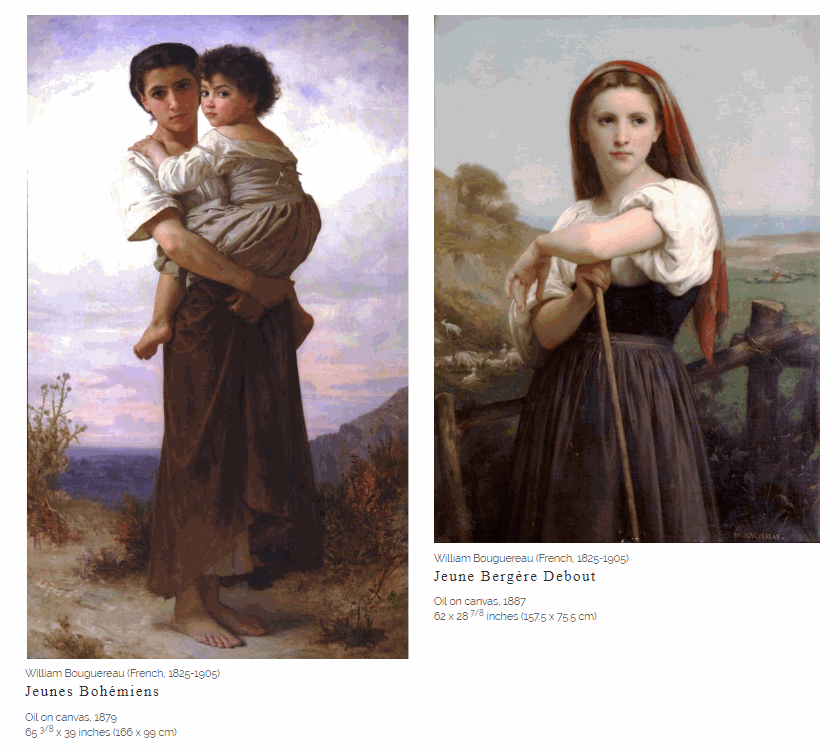
So it is these core beliefs of the Enlightenment, its ideas values and concepts that are so crucial to understanding the context in which the artists of the 19th century lived. They were, in fact, addressing the very heart of Enlightenment thought.
Bouguereau painted young peasant girls with a solemn dignity and a hushed and reverential beauty. One of his works shows a strong but beautiful peasant girl holding a staff and looking at the viewer directly and unabashedly in the eye. She is standing her ground, so to speak.
In another major work, a life-size gypsy mother holds her daughter and both are standing on a mountaintop looking down at the viewer. Their gaze, too, is direct but welcoming. In this painting Bouguereau is elevating these gypsies by silhouetting them against a vast sky with a low horizon line like you might expect in a painting of the Madonna and child. We are looking up to them.
Their kind and welcoming expressions implies their acceptance of us; the viewer is asked to return this show of respect, which can only be properly echoed by our acceptance of them regardless of the lowly status of their birth.
The very truth and reality of their birth once a negative, now elevates them to the heavens… a status wherein all of humanity now resides.
In the 19th Century, all people doing any and all activities were considered worthy subjects and themes for the artists to address. Subjects included paintings of the poor and homeless, women thrown out in the cold by tyrannical husbands, or children toiling until late at night, enduring 16 hour work days.
There were scenes of marriage and children and family life; scenes of schools and courts and hospitals and industry, parks and mountains and countless other topics. For example, a popular theme was of a hypocritical clergy preaching to renounce worldly possessions from their opulent apartments filled with art, antiques and personal servants.
How revolutionary a theme this was for artists. When the French artists Vibert , Brunery and Crogaert satirized the clergy,18 and painted cardinals in sumptuous surroundings, playing cards with pretty young socialites, or hiring the services of a fortune teller, they were saying that the clergy was human and vulnerable to the same weaknesses and frailty of character as other people.
But beyond that, to spoof the clergy represented our newfound freedom of speech. A modernist professor once said to me “how inane and silly to show cardinals in silly poses like that.” His prejudice blinded him from even beginning to figure out what Vibert had done … what rules of conduct he had broken from the prior rulers of society.
We have been taught to elevate artists for breaking rules and conventions of perspective or for undermining realistic drawing, or daring not to follow prior precepts for creating art, but the academic artists who had been on the front lines of culture, helping all of us to win our freedoms and rights, were also helping to create a climate where it was even possible to consider breaking the rules of art; which by comparison is a weak and shallow accomplishment when compared to breaking the rules that lead to our freedom from oppression.
In previous centuries, an artist might have had his head cut off for spoofing cardinals in this way. When writers spoke of modern art and the modern era during the late 1800’s this is what they meant by modern. And indeed these artists were pushing the envelope and showing a gutsy willingness to openly degrade the immorality of aristocracy, clergy and corrupt politicians as well as the unjust laws. This was really “sticking your neck out.”
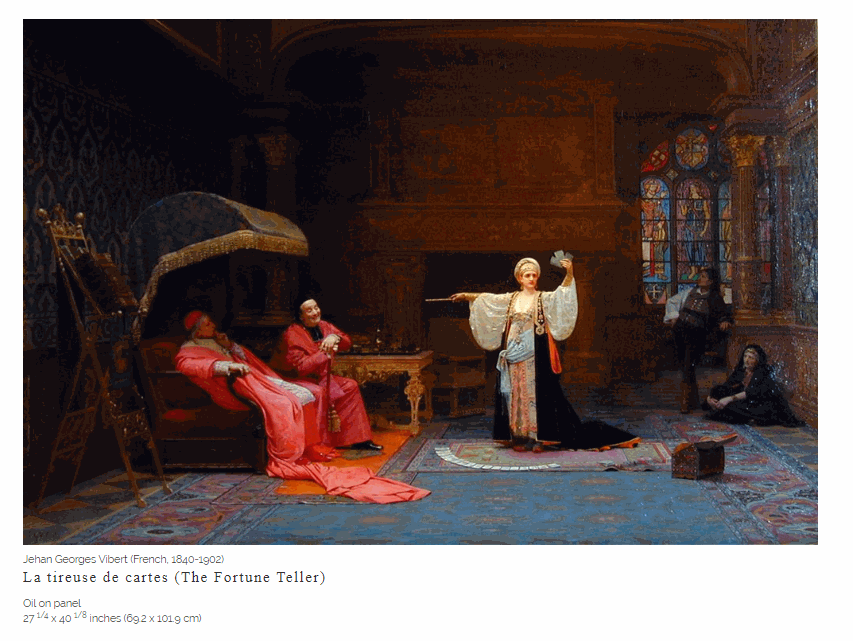
From exposing societal ills and portraying the value and equality of all people, it was but a half step away to explore the personal inner life of individuals and to value and elevate mankind’s hopes, fantasies, and dreams.
For academic artists and writers of the 19th Century, humanity was what counted, and everything that made us human; how we see ourselves and how we see the world.
Humanity was glorified and people of every type and shape, every nationality and color, every occupation and avocation, were represented in their work. We were what counted…we were what was important and we were the greatest of all subjects for the creative bounty of the top artistic minds on earth.
Everything about humanity became the new fodder for the unique forms of communication produced by the writers prose, the poet’s pentameter, and the painter’s pigments. Glorified we were, as thousands of artists produced millions of images, often new and original, and the best of the best of these were masterpieces of the highest order.
Returning then to Beauty and aesthetics
The experience of beauty in fine art also described as Aesthetic sensibilities is therefore inextricably bound to subject and themes about humanity; about life and living and documenting how we see the world and how we feel about life.
It’s clear how this relates directly back to what fine art is all about and what things we as human beings consider beautiful and hold as sacred. Fine art like poetry, literature and theatre achieves beauty by capturing and memorializing those things we as human beings all share and hold dear.
Art is celebrated because it helps us celebrate the human experience. And the creations that communicate some aspect of our shared humanity with beauty, poetry, grace and a respect for human dignity are our greatest works of art.
Aesthetics in the fine arts is equally tied to the formal skill-based elements of drawing painting and sculpture listed earlier in this chapter. The subject and theme chosen by the artist must harmonize with all the other skill-based elements mentioned before and listed below.
Endless numbers of choices and decisions must be made by the artist and a vast array of problems arise and need to be solved during the creative process by always constantly keeping in mind, the subject, theme and the purpose that they have given themselves for each specific work of art.
Since we live in a 3-dimensional world, artists use objects from the real world as part of their visual vocabulary. The achievement of three-dimensional effects, then, increases the strength and success of artwork when using the visual language of realism. Some other factors, principles and parameters, which aid the highly skilled in their pursuit of beauty, are worth noting. Here is an incomplete list of elements for which decisions must be made or problems solved:
- Subtle vs. obvious
- Balance vs. unbalanced
- Homogeneity of execution vs. disconnected, awkward and incongruent whether in shapes, forms, sizes, perspective, shadowing, light source, etc.
- Integration of subject and form
- Integration of subject and form
- Selective focus often achieved through experienced blending of impressionist and academic techniques.
- Accurate drawing skills as fundamental to painting
- Finding the correct contour lines
- Modeling them to create the illusion of three dimensional forms
- Proportions
- Foreshortening
- Perspective
- Lost and found edges or contours
- Juxtaposing of positive and negative space
- Glazing and scumbling
- Brushwork studied color alternatives for creating shadows and highlights that go beyond strict modeling of light and dark.
- Proper preparation of materials: choosing of panel or canvas; stretching the canvas treating the surface and preparing the ground.
- Composition: from an infinite number of possibilities the artist must decide on placement of figures, what they are doing and what expressions should be on their faces, in their body language, and all other elements to include in order to best express the subject and enrich the image, theme or idea being attempted. Limiting those choices to avoid the work becoming too busy as too many objects can be distracting to the theme or idea being attempted.
- Choice of clothing if figures are not to be naked along with which accessories.
- Dramatic and powerful vs. soft and peaceful
- Coloration choices and transitions
- Light and atmosphere
- Size of the work
- Availability of models or other elements that will be needed for reference during the entire process.
- Choice of medium: oils, acrylics, watercolor, pastels
- Color palette and placement. Colors need to be mixed dynamically on the spot and countless decisions concerning colors and blending of color are made in real time while painting.
Modernism has mostly ignored most of these. A work of art that successfully harmonizes subject and theme with all of the elements of painting and drawing listed above is likely to be successful. A work will not be successful, which is inconsistent, awkward, incongruent, lacking in homogeneity, unbalanced, poorly composed, or any combination of many possibilities in which these elements do not harmonize choices which can sabotage and undermine an artist’s goals.
Modern art has eliminated nearly all of the above skills and qualities and made virtually every element formerly considered a virtue into a vice.
Conversely, the vices have become virtues. Can both forms of art exist side by side in college art departments and in our museums? Their goals and beliefs are diametrically opposite from each other.
Perhaps colleges and universities which are not prepared to support or suppress either one would be better advised to have different departments with different faculties.
Ultimately in a world where freedom prevails: freedom to think, to speak and to create whatever kind of art we want for reasons of our own choosing, it will fall to those who acquire art to decide which kinds of art they prefer to beautify their homes, their cities and their world.
People will decide which set of objects and beliefs they wish to elevate, protect and preserve as sacred memorials of their values, their lives and their culture that will pass down to their children and posterity.
My hope is that would-be artists and art historians, by understanding the underlying principles of aesthetic beauty will be in a more informed place from which to examine and decide for themselves between the principles, values and beliefs behind the Modernist paradigm, and those that underlie skill-based and subject-based traditional and contemporary Realism.
Traditional skill-based art in recent decades has had very few proponents, ceding nearly a century to an ascendant modernist leviathan. Ironically, that century has seen the greatest strides forward in every other field of human endeavor. If the proponents of realism are as correct as it seems, the art world is woefully behind our times and will need to do a lot of catching up.
The new Realism movement now has thousands of artists. That is a staggering turn-around from the handful who were working 30 years ago. There are many upscale art galleries in major cities throughout the world who concentrate on art with images from the real world. ARC Living Masters™ and Associate Living Masters™ have taken great strides forward in reclaiming our century's long heritage in Realist fine art. We are now seeing solid indications of the rich creativity developing at the heart of the 21st Century art world. The exhilaration and optimism that flows forward from here could not be more thrilling or more exciting. I can't wait to see the magic and beauty that is in store for us as these artists are inspired by an avalanche of original perspectives, innovative methods, and brilliant game-changing subject matter in a rapidly growing Realist movement… as artists share their ideas together seeding and cross pollenating a landslide of creative and innovative thinking that will lead us to ever more poetic, inspirational and beautiful artwork in the studios, salons and exhibitions in the years that lie ahead. Just half way through the second decade of the first century of this the third millennia, we are truly at the very beginning of a new era that celebrates the beauty and poetry of the human soul.

Fred Ross
Founder and Chairman of the Art Renewal Center, Ross is the leading authority on William Bouguereau and co author of the recently published Catalogue Raisonné William Bouguereau: His Life and Works.
Further Reading
- Bouguereauby Fred Ross
- Abstract Art Is Not Art and Definitely Not Abstract by Fred Ross
- ARC Chairman Speaks at the Ducret School of Art by Fred Ross
Do you want more?
I have more articles in my Art Index here…
ARTArticles & Links
You’ll not find any big banners or popups here talking about cookies and privacy notices. There are no ads on this site (aside from the hosting ads – a necessary evil). Functionally and fundamentally, I just don’t make money off of this blog. It is NOT monetized. Finally, I don’t track you because I just don’t care to.
To go to the MAIN Index;
Master Index.
- You can start reading the articles by going HERE.
- You can visit the Index Page HERE to explore by article subject.
- You can also ask the author some questions. You can go HERE .
- You can find out more about the author HERE.
- If you have concerns or complaints, you can go HERE.
- If you want to make a donation, you can go HERE.
Please kindly help me out in this effort. There is a lot of effort that goes into this disclosure. I could use all the financial support that anyone could provide. Thank you very much.
[wp_paypal_payment]

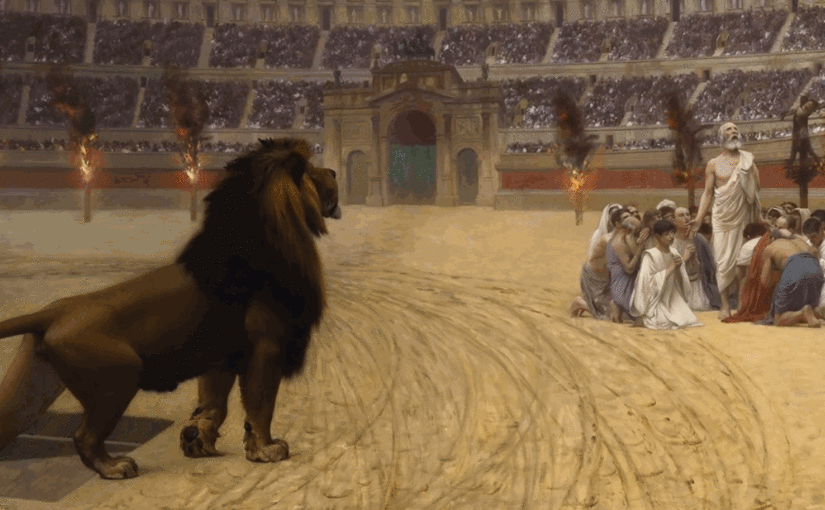

WOW, MM! This is the reason why I come everyday to this joint. It’s like Forrest Gump’s memorable phrase: “Life’s like a box of chocolates. You never know what ya gonna get.” This article has a story for me. I dabble like Mr Jack of All Trades and am definitely Master of none. One point in my life, I just loved art and painted with acrylics – ya know its just stuff u do because u just havent done it, and one day u say WTF, I m gonna do this…. SO, anyway, when you do art, you look at art. And as I am not one of those whose surnames start with an R, I collected art books. And these were pretty good oversized books that you can get for $20-30. Sometimes in a clearout sale you can get great books for $9.99. Im just a junk collector (if u ask my wife) – that’s how I “consume….” Anyway, after at least ten relocations that span oceans, they just ended up lost (actually sold for recycled material on a pound basis) or I kept a couple in storage. I cleared up my storage 2 years ago for good, and decided whatever artbooks were left had to go “to a better place in heaven.” I just kept two. One of them my favorite, that I REALLY WANT TO KEEP was as you guessed it, a hyper amazing REALIST painter who is not well known today. But in his heyday, he was the only artist who was knighted by Queen Victoria – even John Turner and John Constable were not knighted. Anyway, my book (stored for over ten years) was totally destroyed by dried-up moisture and had an inch of dry fungi all over it – and was musty and caused me to sneeze. As far as Im concerned if I took that back and put in on my bookshelf it would be extremely deletrious to my health and handling it would gross me out (it also wouldnt pass the Garmin “Wife-GPS sh*tfinder NO Fucking way that comes into our house” gadget that is automatically installed in all married households). So, it got canned. Took me ten minutes and several book flippings to make that decision. Anyway, your art article today brings back “virtual tears” to my ears as this artist really moves me. I just ordered a pdf book by this artist – might as well get it electronically. His works are all public domain now. If this article interests you, then you gotta check out this artist. You may or may not have my reactions…. BTW, thanks MM for the daily chocolates that u throw out to us. https://www.wikiart.org/en/sir-lawrence-alma-tadema. wikiart is a great place to “appreciate art” is its not convenient for u to go visit the Louvre for example (I’ve never been there. been stuck here living my life…Happily, I might add! “Better than being poked in the eye with a pointy stick” as one of old crocker friends used to say!).
MM sorry to add this, but if you want to GET what the first box’s narrator Fred Ross was saying check out Bougureau’s works https://www.wikiart.org/en/william-adolphe-bouguereau Magnifique. My G*d, I had appreciated Renoirs but they dont really move me. Bougureau is defn ANOTHER league. Do take a look & feel what Fred Ross is saying. Man, that really hits something in me. Thanks, MM!
His stuff is just… stupendous.
Here’s some links to some of my favorite painters. William Bouguereau , Sir Lawrence Alma-Tadema , John William Waterhouse , Frederick Lord Leighton , Ernst Louis Meissonnier , Edward Coley Burne-Jones , Frank Dicksee , Jules Joseph Tissot , John William Godward , they are all amazing!
MM readers, I don’t know if u r just scrolling down this long article and getting a little cross-eyed and perhaps thinking I’ll skip this article. I read it and this one has opened my perceptions on art and the attendant failures and lies of modern society (which is related to the socially engineered decline of the western civiliation). If u like art, this one’s really worth the read. Eye opening & in many ways really tells it like it is. Modern society’s lies are toast in the NW and the ppl who will populate it. THanks, MM!
It’s true. It’s long, but (hopefully) everything at Metallicman will be worthy of your time. There are those that complain that the articles are too long, and that everything here is bullshit. They belong in the American fast-food generation. They do not belong to the future. Here’s some nice art work…
And while I am at it, here are some favorites for artists with whom I have forgotten their names…
Sure is better than this piece… 45.6 million USD…
Thank you for this post. Going to be helpful for me. Having spend 7+ years in higher education “art” programs, here is a glimpse into what we are learning in school these days. And one effect of this is possibly getting the art majors leaving art and going into science and engineering. In my experience, many of the most interesting artist have rigorous STEM education and then find other ways to express their creativity, imagination, and humanity.
https://medium.com/@genekogan/machine-learning-for-artists-e93d20fdb097
As what happened to myself.
The Art Renewal center has a list of Atlers that are actively training students in the old techniques.
I strongly believe that the best human that you can be is to have a balance in ability. Where you can perform some scientific activity, as well as some artistic activity as well. That is NOT what is being taught in schools today. They teach specialization instead.
I am releasing another art related post today. I think that you will enjoy it.
Your comment on POS big painting with blue and yellow in three unequal zones: QUOTE Sure is better than this piece… 45.6 million USD…UNQUOTE. You have actually hit jackpot here. Thanks, for getting to the tip of the point – witha clear picture of insanity. To anyone in the art and investment world who thinks that this piece is worth more than $50, he is crazy(cost of materials)! Proof, I can do the same painting ANYWAY you like. DIfferent colors, different zones ON ORDER for $10,000 and even less. (Heck, I’ll take $500 if u bargain me down. I can sign whatever name u want on that artpiece. Save u a heck of a lotta money. Seriously, u want me to do it, just leave a comment here. If u want I can also for no extra charge smear my actual feces and urine on it – to get that REAL genuine DNA effect. Ya know, might as well do the limit thing. Fer sure, it cant be “forged” as this work has my genuine DNA on it…). BUt if anyone vehemently disagrees with what I just said, well, doesnt the above MM article just proves the point – how he’s been hoodwinked by “the shysters of artspeak” who are experts of sh*tgolding (the art of making sh*t look like gold). I think RPTB and their reps just want to take EVERYTHING to the extreme end of the Hegellian Dialectic to show ppl the truth, you have to tell them EXTREMELY EXAGGERATED LIES, and for those who don’t fall into the echo chambers, or get pushed over the cliff, those who see the “truth” as it simply is, are ppl whose genetic fitness, discerning ability and intelligence are worth saving. That goes for virtualy EVERY ISSUE of importance in this world. What is packaged as truth are actually lies, and it is up to the ppl who are FIT for the NW, see it and know what to do next. BTW, checked out ARC for ateliers, but am not able to find any listing in their education section, perhaps there is a bug on the site. Anyway, for those u who want to dabble when they have time, some ideas: 1) Get 1 book (1 only – dont waste money as u arent sure youll like this) on realism painting and just freely dabble, dont put pressure on urself. See if u like it. 2) Go on useful websites that teach realism painting. This is one of many. https://realisticacrylic.com/ . There are freebies here. so why not freebie-take some home. If u want to enrol, thats up to u. 3)Get FotoSkecher free software that converts pictures into different types of art genres. Then, copy paint using appropriate materials & techniques. This is as shortcut as ur gonna get. This is how u learn. See, practice, do! No regrest! SOrry, MM, I m just a cheapie sort of Macgyver… Cant change that trait in me. Thanks again, MM! Will be reading ur Tissot piece.
“Art is an expression of the soul.” The Masters from the 15th thru 19th centuries had that “special stuff”. The “art” which is most prolific in our era should be deemed corporate art. For it is soulless and uninspiring.
I love this statement. “It should be considered Corporate art for it is souless and uninspired”.
Was curious if you’ve heard of Miles Mathis. http://mileswmathis.com/
He has some interesting research and also creates art.
No I have not. But I just opened up his website. It looks promising. I love his style. I will add him to my art index when I get the opportunity. Thank you so very much for your insight and pointing him out to me.
Also, have you heard of How Should We Then Live by Francis Schaeffer? The book chronicles the decline of Western culture by tracing the decline of our art. I’ve always thought Modern Art was a scam. I’ve read it’s just a means of currency and tax avoidance for the rich which is why the rest of us see it as so ludicrous.
No I have not read that book, but I will pretty much guarantee that it is a good read. This is an interesting subject and it enters the realms of the super-wealthy and powerful. This is how they transfer their money and avoid the hassles that us serfs need to contend with. Thanks for the info!